Stan C. Smith's Blog, page 27
May 17, 2020
Awesome Animal - Vinegaroon
For today's Awesome Animal I decided to pick a creature that looks scary but is actually harmless to humans. In fact, vinegaroons are handy to have around because they often prey on animals that can be harmful, such as scorpions.
VINEGAROON... the name sounds kind of creepy. Also, as one author put it, the name sounds like the most foul-tasting Girl Scout cookie ever.
They look like a cross between a spider and a scorpion, but they are not poisonous, they do not sting, and they are harmless to humans.
But... well, they do have the ability to squirt out a nice mixture of acetic acid and caprylic acid. But only if you make them really mad.

What the heck is a Vinegaroon?
Vinegaroons, also called whip scorpions, make up a small order (only about 100 species) of arachnids. Notice the eight legs in the above photo.
Most people know arachnids include spiders and scorpions. Besides spiders and scorpions, though, there are also some bizarre and lesser known groups of arachnids, such as ticks, mites, harvestmen (daddy longlegs), and others. Now, even horseshoe crabs might be included as arachnids. And of course we have the vinegaroons.
Vinegaroons, although their shape is vaguely scorpion-like, are not closely related to scorpions at all. They have a long, segmented, whip-like "tail" sticking out from the end of their abdomen, which is how they got the name whip scorpion.
They live in the warmer areas of North America, throughout Central and South America, and in the warmer areas of Asia.
Amazing facts about Vinegaroons
Vinegaroons are nocturnal. During the day they live in burrows that they dig with their large, clawed appendages that grow in front of their face. At night they emerge and roam around looking for prey. They mainly prey on insects and millipedes, but sometimes will catch small frogs and other small vertebrates. As you can probably guess, they use those ominous-looking pedipalps (kind of like mandibles) to crush their prey, then they can leisurely lap up the yummy juices that flow out of the squashed creature.
They have a pretty amazing way of finding their prey. Although vinegaroons have eight eyes, those eyes are pretty much useless for seeing prey animals. So, they use their sense of touch. When walking, they mostly use their three back pairs of legs. The fourth pair, near the front of the body, are adapted to be highly-sensitive feelers. As the creature roams around, these two legs tap the ground, feeling for anything that might be a tasty snack. And that long, funny-looking tail? That thing is used to feel around behind the vinegaroon. So, it can detect any suspicious activity or potential food in front and in back.
Check out those thin, extra-long, "feely" legs and the "feely" butt protuberance on the vinegaroon below.
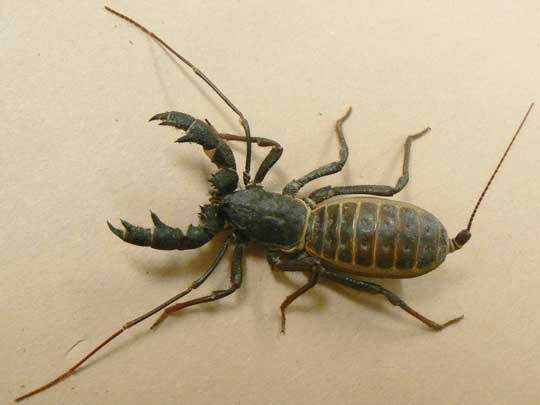
Here's a good question. The vinegaroon is obviously a nice, plump critter, probably packed with nutrients. Also, the vinegaroon doesn't sting (remember, it isn't a scorpion), and although those pedipalps look vicious, they can't squeeze hard enough to hurt anything bigger than a peanut shell. So, why don't predators gobble up these creatures like crunchy popcorn? Well, remember that vinegaroons have a pretty cool defense—they squirt acid.
At the base of that long, feely tail are pygidial glands. These glands produce a mixture of chemicals consisting primarily of acetic acid and caprylic acid. You've probably heard of acetic acid. It's the main ingredient in vinegar.
Note: Vinegar contains 5% acetic acid, whereas the mixture squirted from a vinegaroon's butt has 85% acetic acid. Imagine the taste and smell of this stuff!
Check out this video with slow-motion clips of a vinegaroon squirting acid.
When really bothered, the vinegaroon can squirt this mixture out about twelve inches (30.5 cm) in any direction.

Wait... that's it? It's only defense (other than looking like the devil's spawn) is to squirt vinegar? Heck, some people put vinegar on their salads!
Well, a vinegaroon can accurately aim its acid butt-nozzles, and it's pretty good at squirting the stuff directly into the eyes, nose, and mouth of its predators. Remember, the stuff is 15 times more concentrated acetic acid than vinegar. Not something I want squirted in my eyes. Nope.
As a last resort, if the acid spray doesn't work, the vinegaroon will face off with its harasser and strike an impressive "back-off" pose (see photo above). Those pedipalps may not be as strong as they look, but it's all in the attitude.
Okay, let's move on to the important stuff... making babies. Vinegaroons have an astoundingly elaborate, drawn-out courtship ritual, which can often last at least 13 hours! This is a multi-stage procedure, so stay with me on this...
Stage 1. If a male encounters a female as he is out roaming around at night, he chases her down and begins shoving her around with his pedipalps. They grapple back and forth like this for up to several hours. It's a way for the female to determine if the male is good and strong (she is not interested in having the babies of a weakling). If the female decides he's okay, she will signal this by sticking her long, feely forelimbs into his mouth.
Stage 2. This stage is all about... dancing. The male, still holding the female's sensory legs in his mouth, starts dragging her this way and that way in an elaborate dance. During this dance, the female follows his lead. Again, this is to further evaluate each other's worth as a mate. This dance goes on for three or four hours. Sounds rather exhausting to me.
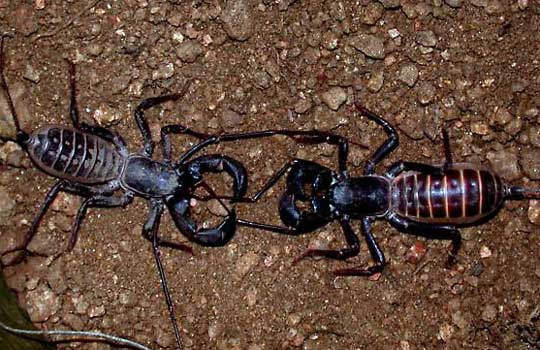
Stage 3. Time to get down to business... very slowly. By this time, if the two vinegaroons still approve of each other, the male will have maneuvered the female toward a burrow. Still holding on to the female's feely legs, he turns around and positions himself on top of her. They stay like this for several more hours. Eventually, the male will deposit a sac of sperm (called a spermatophore) onto the ground. He pushes the spermatophore into the female's genital opening. Finally, the male releases her feely legs and then starts massaging her abdomen. This massage goes on for a few more hours. The purpose of this might be to help the sperm move deeper into the female's body.
Stage 4. Well, there is no stage 4. After all those hours of courtship and mating, the male and female mutually agree to part ways. The female does not cannibalize the male, as is the case with many spiders. Yay for him!
The female carries the eggs for several months and then eventually seals herself in a burrow. She lays the eggs, but they stay connected to her abdomen for several more months. Um... during these months, the female vinegaroon does not eat anything. Nothing. Wow.
The eggs hatch, and out come larvae that look like pieces of rice with tiny legs. The larvae climb up onto the top of the female's abdomen and hang on with a specialized sucker organ for... yep, another month. finally, after their first molt, the babies start to wander off around the burrow. When she finally decides they are ready to be on their own, she digs out of the burrow, releasing them to take off and start their own lives. Exhausted and hungry, the female can finally get on with her life!
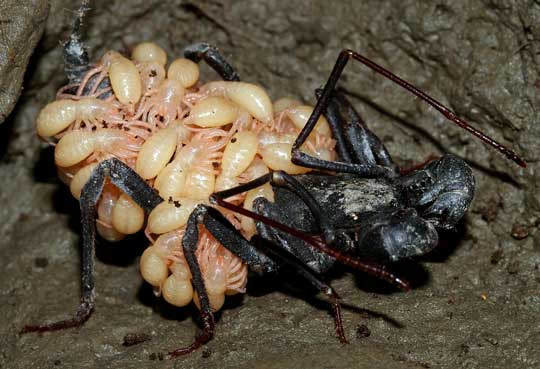
So, Vinegaroons deserve a place in the S.A.H.O.F.
(Supernal Animal Hall of Fame).
FUN FACT: The word supernal originated in the mid 1400s. It comes from the Latin supernus, meaning "situated above, that is above; celestial." Originally, the English word supernal meant "being in or belonging to the heaven of divine beings; heavenly, celestial, or divine." It is the opposite of infernal, which refers to "being of the underworld." For Kristen Bell fans, supernal means from The Good Place, while infernal refers to The Bad Place. Anyway, like many words, its usage has broadened so that it now often refers to anything that is exquisite or superlative. So, supernal is another way to say awesome!
Photo Credits:
Vinegaroon in hand #1 - Wikimedia Commons
Vinegaroon feeler legs and tail - Insect Adventure
Vinegaroon facing camera - Jonathon's Jungle Roadshow
Vinegaroons mating - Arlo Pelegrin via BugGuide
Vinegaroon with babies - Cowyeow on Flickr
VINEGAROON... the name sounds kind of creepy. Also, as one author put it, the name sounds like the most foul-tasting Girl Scout cookie ever.
They look like a cross between a spider and a scorpion, but they are not poisonous, they do not sting, and they are harmless to humans.
But... well, they do have the ability to squirt out a nice mixture of acetic acid and caprylic acid. But only if you make them really mad.

What the heck is a Vinegaroon?
Vinegaroons, also called whip scorpions, make up a small order (only about 100 species) of arachnids. Notice the eight legs in the above photo.
Most people know arachnids include spiders and scorpions. Besides spiders and scorpions, though, there are also some bizarre and lesser known groups of arachnids, such as ticks, mites, harvestmen (daddy longlegs), and others. Now, even horseshoe crabs might be included as arachnids. And of course we have the vinegaroons.
Vinegaroons, although their shape is vaguely scorpion-like, are not closely related to scorpions at all. They have a long, segmented, whip-like "tail" sticking out from the end of their abdomen, which is how they got the name whip scorpion.
They live in the warmer areas of North America, throughout Central and South America, and in the warmer areas of Asia.
Amazing facts about Vinegaroons
Vinegaroons are nocturnal. During the day they live in burrows that they dig with their large, clawed appendages that grow in front of their face. At night they emerge and roam around looking for prey. They mainly prey on insects and millipedes, but sometimes will catch small frogs and other small vertebrates. As you can probably guess, they use those ominous-looking pedipalps (kind of like mandibles) to crush their prey, then they can leisurely lap up the yummy juices that flow out of the squashed creature.
They have a pretty amazing way of finding their prey. Although vinegaroons have eight eyes, those eyes are pretty much useless for seeing prey animals. So, they use their sense of touch. When walking, they mostly use their three back pairs of legs. The fourth pair, near the front of the body, are adapted to be highly-sensitive feelers. As the creature roams around, these two legs tap the ground, feeling for anything that might be a tasty snack. And that long, funny-looking tail? That thing is used to feel around behind the vinegaroon. So, it can detect any suspicious activity or potential food in front and in back.
Check out those thin, extra-long, "feely" legs and the "feely" butt protuberance on the vinegaroon below.

Here's a good question. The vinegaroon is obviously a nice, plump critter, probably packed with nutrients. Also, the vinegaroon doesn't sting (remember, it isn't a scorpion), and although those pedipalps look vicious, they can't squeeze hard enough to hurt anything bigger than a peanut shell. So, why don't predators gobble up these creatures like crunchy popcorn? Well, remember that vinegaroons have a pretty cool defense—they squirt acid.
At the base of that long, feely tail are pygidial glands. These glands produce a mixture of chemicals consisting primarily of acetic acid and caprylic acid. You've probably heard of acetic acid. It's the main ingredient in vinegar.
Note: Vinegar contains 5% acetic acid, whereas the mixture squirted from a vinegaroon's butt has 85% acetic acid. Imagine the taste and smell of this stuff!
Check out this video with slow-motion clips of a vinegaroon squirting acid.
When really bothered, the vinegaroon can squirt this mixture out about twelve inches (30.5 cm) in any direction.

Wait... that's it? It's only defense (other than looking like the devil's spawn) is to squirt vinegar? Heck, some people put vinegar on their salads!
Well, a vinegaroon can accurately aim its acid butt-nozzles, and it's pretty good at squirting the stuff directly into the eyes, nose, and mouth of its predators. Remember, the stuff is 15 times more concentrated acetic acid than vinegar. Not something I want squirted in my eyes. Nope.
As a last resort, if the acid spray doesn't work, the vinegaroon will face off with its harasser and strike an impressive "back-off" pose (see photo above). Those pedipalps may not be as strong as they look, but it's all in the attitude.
Okay, let's move on to the important stuff... making babies. Vinegaroons have an astoundingly elaborate, drawn-out courtship ritual, which can often last at least 13 hours! This is a multi-stage procedure, so stay with me on this...
Stage 1. If a male encounters a female as he is out roaming around at night, he chases her down and begins shoving her around with his pedipalps. They grapple back and forth like this for up to several hours. It's a way for the female to determine if the male is good and strong (she is not interested in having the babies of a weakling). If the female decides he's okay, she will signal this by sticking her long, feely forelimbs into his mouth.
Stage 2. This stage is all about... dancing. The male, still holding the female's sensory legs in his mouth, starts dragging her this way and that way in an elaborate dance. During this dance, the female follows his lead. Again, this is to further evaluate each other's worth as a mate. This dance goes on for three or four hours. Sounds rather exhausting to me.

Stage 3. Time to get down to business... very slowly. By this time, if the two vinegaroons still approve of each other, the male will have maneuvered the female toward a burrow. Still holding on to the female's feely legs, he turns around and positions himself on top of her. They stay like this for several more hours. Eventually, the male will deposit a sac of sperm (called a spermatophore) onto the ground. He pushes the spermatophore into the female's genital opening. Finally, the male releases her feely legs and then starts massaging her abdomen. This massage goes on for a few more hours. The purpose of this might be to help the sperm move deeper into the female's body.
Stage 4. Well, there is no stage 4. After all those hours of courtship and mating, the male and female mutually agree to part ways. The female does not cannibalize the male, as is the case with many spiders. Yay for him!
The female carries the eggs for several months and then eventually seals herself in a burrow. She lays the eggs, but they stay connected to her abdomen for several more months. Um... during these months, the female vinegaroon does not eat anything. Nothing. Wow.
The eggs hatch, and out come larvae that look like pieces of rice with tiny legs. The larvae climb up onto the top of the female's abdomen and hang on with a specialized sucker organ for... yep, another month. finally, after their first molt, the babies start to wander off around the burrow. When she finally decides they are ready to be on their own, she digs out of the burrow, releasing them to take off and start their own lives. Exhausted and hungry, the female can finally get on with her life!

So, Vinegaroons deserve a place in the S.A.H.O.F.
(Supernal Animal Hall of Fame).
FUN FACT: The word supernal originated in the mid 1400s. It comes from the Latin supernus, meaning "situated above, that is above; celestial." Originally, the English word supernal meant "being in or belonging to the heaven of divine beings; heavenly, celestial, or divine." It is the opposite of infernal, which refers to "being of the underworld." For Kristen Bell fans, supernal means from The Good Place, while infernal refers to The Bad Place. Anyway, like many words, its usage has broadened so that it now often refers to anything that is exquisite or superlative. So, supernal is another way to say awesome!
Photo Credits:
Vinegaroon in hand #1 - Wikimedia Commons
Vinegaroon feeler legs and tail - Insect Adventure
Vinegaroon facing camera - Jonathon's Jungle Roadshow
Vinegaroons mating - Arlo Pelegrin via BugGuide
Vinegaroon with babies - Cowyeow on Flickr
Published on May 17, 2020 05:21
April 28, 2020
Awesome Animal - Legless Lizard
I was probably about ten years old when I saw my first legless lizard. I was fishing with my dad and his friend, who happened to be a biologist. We came upon what I thought was a snake. But my dad's friend pointed out that it was actually a "slender glass lizard," a type of lizard without legs. This blew my mind! A long, skinny reptile without legs had to be a snake, right? Nope, not necessarily. Consequently, I've been fascinated by legless lizards ever since then. Below is a slender glass lizard, the same kind I saw that day fifty years ago.

What the heck is a Legless Lizard?
Actually, the term legless lizard is used to refer to a variety of different types of lizards that have lost their legs over time. In different areas of the world, these different groups have lost their legs independently of each other and are not closely related.
Amazingly, at least SEVEN different families of lizards have evolved legless species independently! This includes hundreds of species of legless lizards around the world.
The first question people often have is, why don't we just call these creatures snakes ? Well, because they aren't snakes. Other than being legless, these creatures do not have the characteristics of snakes. Legless lizards have eyelids, snakes do not. Legless lizards have external ears, snakes do not. Legless lizards do not have wide belly scales, snake do. Legless lizards have short bodies and long tails, snakes have long bodies and short tails.
Not confusing at all, right? Check out the head of the European glass lizard below (this species also has the awesome name scheltopusik). You can see the lizard's eyelids, which allows it to close its eyes. You can also see its ear openings (behind the mouth). And behind that you can see part of the lateral fold, a weird fold of skin that runs the length of the lizard on each side. Snakes do not have any of these characteristics.

Amazing facts about Legless Lizards
Again, legless lizards are not snakes. They evolved from four-legged lizards, like those we have all seen. Snakes evolved from four-legged snake-like creatures that most of us have never seen (most of those lived long ago).
Legless lizards eat smaller prey than snakes because they cannot "unlock" their jaws. As you probably know, snakes can unhinge their jaws to swallow prey bigger around than their own head. Lizards cannot do this. Legless lizards typically eat insects, snails, spiders, and other small prey that will fit conveniently in their mouth. So, a typical snake will eat just occasionally, swallowing an animal large enough to sustain it for a while. A legless lizard eats small things frequently.
Below is a Burton's legless lizard eating a smaller lizard.
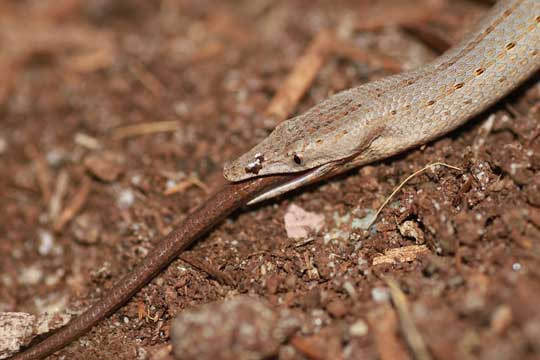
Many legless lizards are called glass lizards. Here's why. You may know some lizards are capable of losing all or a portion of their tail when attacked by a predator. They can then grow the tail back (at least partially). Well, glass lizards are very good at this. Not only do they have a really long tail, but the tail is extremely fragile. In fact, they can even break their tail off by themselves. They can actually thrash around hard enough to break it off without ever being touched. Since that day fifty years ago, I have found perhaps twenty or so slender glass lizards, and almost all of them had broken their tail at some point in their lives. You can easily tell because, once broken, the tail does not grow back the same way as before.
Notice the regenerated tail of the eastern glass lizard below.
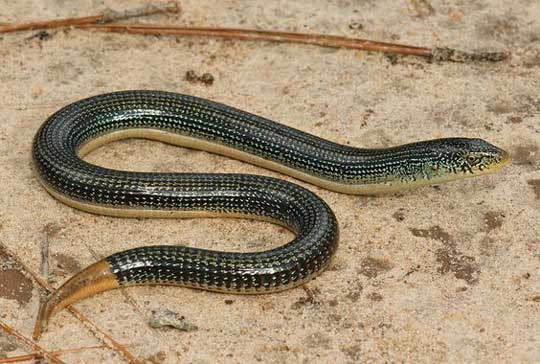
This tail-breaking ability is called caudal autotomy (the word autotomy in Greek means "self severing"). This is really an amazing capability—the tail continues wriggling, which distracts the predator's attention from the fleeing lizard. As the lizard gradually regenerates the tail, instead of growing new vertebrae made of bone, the tail usually contains cartilage and is shorter than the original tail. Lizards have special sphincter muscles in the tail that squeeze the caudal artery closed to minimize the amount of bleeding.
Fossils have been found that show caudal autotomy was present in some lizards as long ago as the Jurassic period! Most likely, small lizards were escaping from the clutches of dinosaurs by dropping their tails!
Check out this video by Jungle Bob on legless lizards.
Okay, one last thing... WHY? Why have so many species of lizards evolved to have no legs? Wouldn't they be better off with legs? Well, first of all, we have to recognize that the long, slithery, legless lifestyle must be a pretty good one. Otherwise, snakes and legless lizards wouldn't be so abundant. It also helps to consider that creatures living underground may be better off without legs (think about worms).
So, it's quite possible legless lizards evolved as some types of lizards started living in the soil. As they became more and more adapted to life in the soil, they gradually lost their legs. Then, later, some of those started living above ground again, but by that time they had already lost their legs. Makes perfect sense, right?
To make things even more confusing, there are some snakes that still have remnants of legs (boas and pythons are examples), and there are some legless lizards that have legs! Legless lizards in the family Pygopodidae don't have forelimbs, but they have small remnants of hind legs.
Make up your mind, why don't you! Legs or no legs?
Hmm... whoever came up with the phrase "Leaping lizards!" probably wasn't thinking about legless lizards. I just thought I'd toss that thought into the mix. You're welcome.
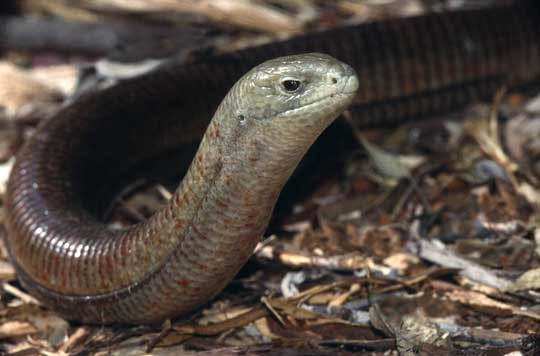
So, Legless Lizards deserve a place in the J.D.A.H.O.F.
(Jim-Dandy Animal Hall of Fame).
FUN FACT: The term jim-dandy was first used in the Courier-Journal newspaper in Louisville, Kentucky in 1887: "Dear Sir: Though a stranger to you (yet a Democrat), let me say you are a 'Jim Dandy.'" This term can be both a noun (as used above) and an adjective. As a noun, it means something that is "a superior example of its kind." As an adjective, it means excellent or outstanding. Etymologists are not sure if the term ever referred to an actual person. But there was a popular minstrel song in the 1840s called "Dandy Jim of Caroline." Perhaps that's what gave people the idea of using the phrase? The word dandy dates back to the late 1700s, and it referred to a young man "who devotes excessive attention to fashionable dress and grooming." Anyway, jim-dandy is another way to say awesome! Photo Credits:
Baby elephant trunk - Imgur
Sloth - finstad4
Slender glass lizard - Todd Pierson, Herps of NC
European glass lizard head - Australian Reptile Park
Burton's Legless lizard eating a skink - Luke Jongens/Flickr
Eastern glass lizard with regenerated tail - Pinterest
Legless lizard lifting its head - San Diego Zoo

What the heck is a Legless Lizard?
Actually, the term legless lizard is used to refer to a variety of different types of lizards that have lost their legs over time. In different areas of the world, these different groups have lost their legs independently of each other and are not closely related.
Amazingly, at least SEVEN different families of lizards have evolved legless species independently! This includes hundreds of species of legless lizards around the world.
The first question people often have is, why don't we just call these creatures snakes ? Well, because they aren't snakes. Other than being legless, these creatures do not have the characteristics of snakes. Legless lizards have eyelids, snakes do not. Legless lizards have external ears, snakes do not. Legless lizards do not have wide belly scales, snake do. Legless lizards have short bodies and long tails, snakes have long bodies and short tails.
Not confusing at all, right? Check out the head of the European glass lizard below (this species also has the awesome name scheltopusik). You can see the lizard's eyelids, which allows it to close its eyes. You can also see its ear openings (behind the mouth). And behind that you can see part of the lateral fold, a weird fold of skin that runs the length of the lizard on each side. Snakes do not have any of these characteristics.

Amazing facts about Legless Lizards
Again, legless lizards are not snakes. They evolved from four-legged lizards, like those we have all seen. Snakes evolved from four-legged snake-like creatures that most of us have never seen (most of those lived long ago).
Legless lizards eat smaller prey than snakes because they cannot "unlock" their jaws. As you probably know, snakes can unhinge their jaws to swallow prey bigger around than their own head. Lizards cannot do this. Legless lizards typically eat insects, snails, spiders, and other small prey that will fit conveniently in their mouth. So, a typical snake will eat just occasionally, swallowing an animal large enough to sustain it for a while. A legless lizard eats small things frequently.
Below is a Burton's legless lizard eating a smaller lizard.

Many legless lizards are called glass lizards. Here's why. You may know some lizards are capable of losing all or a portion of their tail when attacked by a predator. They can then grow the tail back (at least partially). Well, glass lizards are very good at this. Not only do they have a really long tail, but the tail is extremely fragile. In fact, they can even break their tail off by themselves. They can actually thrash around hard enough to break it off without ever being touched. Since that day fifty years ago, I have found perhaps twenty or so slender glass lizards, and almost all of them had broken their tail at some point in their lives. You can easily tell because, once broken, the tail does not grow back the same way as before.
Notice the regenerated tail of the eastern glass lizard below.

This tail-breaking ability is called caudal autotomy (the word autotomy in Greek means "self severing"). This is really an amazing capability—the tail continues wriggling, which distracts the predator's attention from the fleeing lizard. As the lizard gradually regenerates the tail, instead of growing new vertebrae made of bone, the tail usually contains cartilage and is shorter than the original tail. Lizards have special sphincter muscles in the tail that squeeze the caudal artery closed to minimize the amount of bleeding.
Fossils have been found that show caudal autotomy was present in some lizards as long ago as the Jurassic period! Most likely, small lizards were escaping from the clutches of dinosaurs by dropping their tails!
Check out this video by Jungle Bob on legless lizards.
Okay, one last thing... WHY? Why have so many species of lizards evolved to have no legs? Wouldn't they be better off with legs? Well, first of all, we have to recognize that the long, slithery, legless lifestyle must be a pretty good one. Otherwise, snakes and legless lizards wouldn't be so abundant. It also helps to consider that creatures living underground may be better off without legs (think about worms).
So, it's quite possible legless lizards evolved as some types of lizards started living in the soil. As they became more and more adapted to life in the soil, they gradually lost their legs. Then, later, some of those started living above ground again, but by that time they had already lost their legs. Makes perfect sense, right?
To make things even more confusing, there are some snakes that still have remnants of legs (boas and pythons are examples), and there are some legless lizards that have legs! Legless lizards in the family Pygopodidae don't have forelimbs, but they have small remnants of hind legs.
Make up your mind, why don't you! Legs or no legs?
Hmm... whoever came up with the phrase "Leaping lizards!" probably wasn't thinking about legless lizards. I just thought I'd toss that thought into the mix. You're welcome.

So, Legless Lizards deserve a place in the J.D.A.H.O.F.
(Jim-Dandy Animal Hall of Fame).
FUN FACT: The term jim-dandy was first used in the Courier-Journal newspaper in Louisville, Kentucky in 1887: "Dear Sir: Though a stranger to you (yet a Democrat), let me say you are a 'Jim Dandy.'" This term can be both a noun (as used above) and an adjective. As a noun, it means something that is "a superior example of its kind." As an adjective, it means excellent or outstanding. Etymologists are not sure if the term ever referred to an actual person. But there was a popular minstrel song in the 1840s called "Dandy Jim of Caroline." Perhaps that's what gave people the idea of using the phrase? The word dandy dates back to the late 1700s, and it referred to a young man "who devotes excessive attention to fashionable dress and grooming." Anyway, jim-dandy is another way to say awesome! Photo Credits:
Baby elephant trunk - Imgur
Sloth - finstad4
Slender glass lizard - Todd Pierson, Herps of NC
European glass lizard head - Australian Reptile Park
Burton's Legless lizard eating a skink - Luke Jongens/Flickr
Eastern glass lizard with regenerated tail - Pinterest
Legless lizard lifting its head - San Diego Zoo
Published on April 28, 2020 15:04
April 15, 2020
Awesome Animal - Coral
In keeping with my theme of positive, happy subjects, I again asked Trish to give me an idea for an animal that makes her happy (last time she said Nemo... the clownfish). This time she said, "My happiest happy place is snorkeling in a coral reef! So you should feature coral."
Trish wasn't kidding about this. I enjoy snorkeling, too, but to her it is almost a spiritual experience. She actually tears up when snorkeling among the corals (have you ever tried wiping tears away while wearing a face mask?). So, coral is another excellent suggestion. Besides, some people may not really know what corals are... or that they are even animals. So let's take a look.

What the heck is a Coral?
Corals are invertebrate animals in the phylum Cnidaria, which also includes sea anemones, sea pens, jellyfish, box jellyfish, and hydrozoans such as the Portuguese Man o' War.
Actually, it's kind of silly of me to lump all types of corals together in this email, as corals represent a diverse group of animals. After all, there are about 2,500 species. Of those, about 1,000 species are reef-forming corals. These are the corals that form a hard skeleton by secreting calcium carbonate. Over many years these hard skeletons build up and form massive coral reefs.
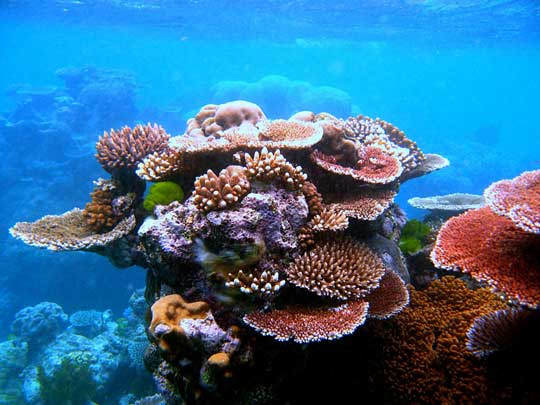
Amazing facts about Corals
First let's talk about what a coral is. Corals generally live in large colonies of genetically-identical individuals. Each individual coral is called a polyp.
If you look at an individual polyp, you will see tentacles. In the center of the tentacles is a mouth that leads to a basic stomach, or digestive sac. Each of the tentacles is lined with stinging cells called nematocysts. As you can probably guess, these stinging cells help the coral defend itself and help it capture its prey, which is usually tiny animals swimming in the surrounding water.
The polyp's body secretes calcium carbonate that forms a hard protective shell around the polyp. This cup-like shell is called a corallite. Over time, millions of corallites build up upon each other to form massive coral reefs and outcrops (see the coral outcrop in the photo above). Some coral reefs are big enough to be seen from space!
Below is a simple diagram.
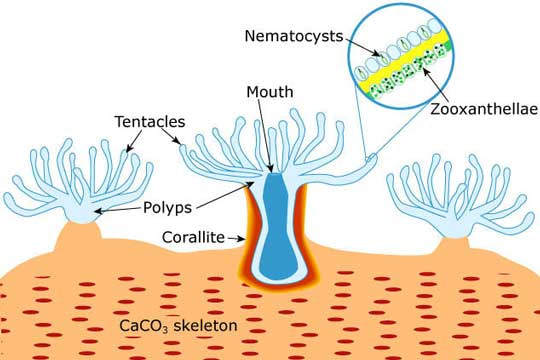
Coral polyps have only one opening. Yep, only one—the mouth. That means food goes in the mouth, and waste goes... well, back out the mouth. Eww. I'm glad I have an anus.
Nematocysts (stinging cells) are pretty awesome. If you've ever been stung by a jellyfish, you know how awesome nematocysts are (awesome for the jellyfish, not for you).
Let's look at how these nematocysts work. Basically, they're like a spear gun shooting a barbed dart, and the dart contain toxins that can be lethal. These tiny darts are contained within a cellular capsule, connected to a thread that is coiled up under pressure. When a prey animal touches the polyp's tentacle, the cellular capsule's covering (called the operculum) pops open, and the thread rapidly uncoils, shooting the dart out at high speed. The dart punctures the prey animal and releases its toxins. Like I said... awesome!
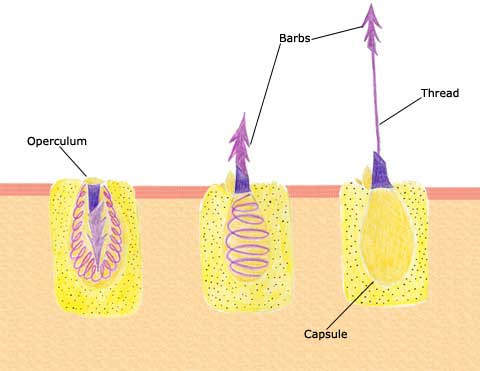
If you've ever snorkeled in a coral reef, you may be thinking, "Wait, I didn't see all those tentacles. All I saw were the hard coral boulders, outcrops, and reefs." Well, that's probably because many corals extend their tentacles mainly at night.
By the way. Snorkeling at night in the ocean or sea can be amazing, but it's also kind of scary. Trish and I have done this twice (while taking marine biology classes together), and I can tell you there is something deeply frightening (but also exhilarating) about not being able to see in the water beyond the range of your waterproof flashlight. It's worth it, though, because the corals are particularly beautiful at night!
Below is what corals usually look like during the day (left) and at night (right).

Corals eat just about anything they can catch, from nearly-microscopic plankton to small fish. Whatever they can kill with their stinging cells is fair game.
But wait! It's not that simple. Many corals also feed in a different way. They have a mutualistic relationship with specialized algae called zooxanthellae. These algae live on and in the coral polyp and can actually be 30% of the polyp's mass.
What does the coral polyp get out of this relationship? The algae are photosynthetic, which means they use sunlight to produce food, and they share that food with the polyp, particularly glucose, glycerol, and amino acids. The algae also help by removing waste particles, and they help with producing the hard shell, the corallite.
What do the algae get out of this relationship? Well, they get a safe place to live, protected by those awesome stinging cells. They also get to feed on the polyp's yummy waste, particularly carbon dioxide, phosphate, and nitrogenous waste.
I should point out that, when water conditions get bad, the internal algae can become stressful to the polyp. When this happens, the polyp will eject the algae in order to give itself a better chance to survive the difficult times. When the water gets really bad, mass ejections can occur, and this is called coral bleaching. Vast areas of coral reefs can turn white, because it was the algae that gave the corals their diverse colors in the first place. Coral bleaching can be caused by pollution or by an increase in water temperature. If the bad conditions continue for too long, the coral polyps will die.
The image below shows the before and after appearance of coral bleaching. Unfortunately, coal bleaching is becoming a big problem, but since this email is all about being positive, I'm not going to focus too much on that.

Here are a few more amazing facts about coral.
Corals have been around for a long time. They originated about 500 million years ago, long before dinosaurs existed. Coral reefs grow very slowly, only about 2 cm per year, and some of today's reefs have been forming for 50 million years.
When coral reefs grow parallel to the coast, they are called barrier reefs. The Great Barrier Reef in Australia has grown to include 900 smaller reefs, and it extends for 2,600 miles (4,184 km).
Coral reefs provide a home for an incredible variety of wildlife. Coral reefs take up only about 1% of the ocean floor, but they provide a home for as much as 25% of all species in the oceans!
White sandy beaches are actually made of coral pooped from fish. Yep, it's true. Some types of fish, such as parrotfish, like to nibble on corals to eat the algae living in the polyps. Once the fish have digested the goodies, they poop out the hard calcium carbonate shell as tiny granules of sand. These sandy poop granules help make up those nice white beaches we all like to lay on. Check out the beak on the purplestreak parrotfish below. That beak can chomp right through the coral shell, and one parrotfish can poop out 200 pounds (90 kg) of white sand per year!
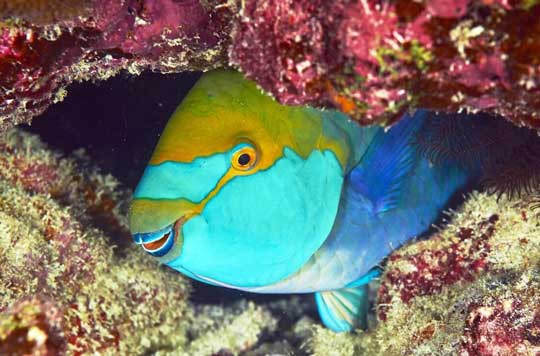
So, Corals deserve a place in the C.A.H.O.F.
(Corking Animal Hall of Fame).
FUN FACT: The word corking originated in about 1890, and is used, particularly in British English, as an adjective to describe something as excellent or fine. Example: "It was a corking celebration." Often it is paired with another word, particularly good, as in "That Bridgers book was a corking good read." Anyway, the word corking came from the word corker. The word corker is a slang term from the early 1800s that originally meant “something that settles and puts a definite end to a discussion or argument,” a reference to how a cork tightly seals a wine bottle. Then corker was eventually used to describe anything as good or excellent: "That was a corker of a joke." Eventually, the adjective corking arose from that.
So, corking is another way to say awesome!
Photo Credits:
Happy dog - Twitter
Penguin rover - Le Maho et. al via Nature... via Buzzfeed
Giraffe Manor - The Giraffe Manor
Coral outcrop in Australia - Toby Hudson/Wikimedia Commons
Coral anatomy - USGS/Public Domain
Bleached coral - Green and Growing
Parrotfish - metha1819/Shutterstock via Marine Conservation Society
Trish wasn't kidding about this. I enjoy snorkeling, too, but to her it is almost a spiritual experience. She actually tears up when snorkeling among the corals (have you ever tried wiping tears away while wearing a face mask?). So, coral is another excellent suggestion. Besides, some people may not really know what corals are... or that they are even animals. So let's take a look.

What the heck is a Coral?
Corals are invertebrate animals in the phylum Cnidaria, which also includes sea anemones, sea pens, jellyfish, box jellyfish, and hydrozoans such as the Portuguese Man o' War.
Actually, it's kind of silly of me to lump all types of corals together in this email, as corals represent a diverse group of animals. After all, there are about 2,500 species. Of those, about 1,000 species are reef-forming corals. These are the corals that form a hard skeleton by secreting calcium carbonate. Over many years these hard skeletons build up and form massive coral reefs.

Amazing facts about Corals
First let's talk about what a coral is. Corals generally live in large colonies of genetically-identical individuals. Each individual coral is called a polyp.
If you look at an individual polyp, you will see tentacles. In the center of the tentacles is a mouth that leads to a basic stomach, or digestive sac. Each of the tentacles is lined with stinging cells called nematocysts. As you can probably guess, these stinging cells help the coral defend itself and help it capture its prey, which is usually tiny animals swimming in the surrounding water.
The polyp's body secretes calcium carbonate that forms a hard protective shell around the polyp. This cup-like shell is called a corallite. Over time, millions of corallites build up upon each other to form massive coral reefs and outcrops (see the coral outcrop in the photo above). Some coral reefs are big enough to be seen from space!
Below is a simple diagram.

Coral polyps have only one opening. Yep, only one—the mouth. That means food goes in the mouth, and waste goes... well, back out the mouth. Eww. I'm glad I have an anus.
Nematocysts (stinging cells) are pretty awesome. If you've ever been stung by a jellyfish, you know how awesome nematocysts are (awesome for the jellyfish, not for you).
Let's look at how these nematocysts work. Basically, they're like a spear gun shooting a barbed dart, and the dart contain toxins that can be lethal. These tiny darts are contained within a cellular capsule, connected to a thread that is coiled up under pressure. When a prey animal touches the polyp's tentacle, the cellular capsule's covering (called the operculum) pops open, and the thread rapidly uncoils, shooting the dart out at high speed. The dart punctures the prey animal and releases its toxins. Like I said... awesome!

If you've ever snorkeled in a coral reef, you may be thinking, "Wait, I didn't see all those tentacles. All I saw were the hard coral boulders, outcrops, and reefs." Well, that's probably because many corals extend their tentacles mainly at night.
By the way. Snorkeling at night in the ocean or sea can be amazing, but it's also kind of scary. Trish and I have done this twice (while taking marine biology classes together), and I can tell you there is something deeply frightening (but also exhilarating) about not being able to see in the water beyond the range of your waterproof flashlight. It's worth it, though, because the corals are particularly beautiful at night!
Below is what corals usually look like during the day (left) and at night (right).

Corals eat just about anything they can catch, from nearly-microscopic plankton to small fish. Whatever they can kill with their stinging cells is fair game.
But wait! It's not that simple. Many corals also feed in a different way. They have a mutualistic relationship with specialized algae called zooxanthellae. These algae live on and in the coral polyp and can actually be 30% of the polyp's mass.
What does the coral polyp get out of this relationship? The algae are photosynthetic, which means they use sunlight to produce food, and they share that food with the polyp, particularly glucose, glycerol, and amino acids. The algae also help by removing waste particles, and they help with producing the hard shell, the corallite.
What do the algae get out of this relationship? Well, they get a safe place to live, protected by those awesome stinging cells. They also get to feed on the polyp's yummy waste, particularly carbon dioxide, phosphate, and nitrogenous waste.
I should point out that, when water conditions get bad, the internal algae can become stressful to the polyp. When this happens, the polyp will eject the algae in order to give itself a better chance to survive the difficult times. When the water gets really bad, mass ejections can occur, and this is called coral bleaching. Vast areas of coral reefs can turn white, because it was the algae that gave the corals their diverse colors in the first place. Coral bleaching can be caused by pollution or by an increase in water temperature. If the bad conditions continue for too long, the coral polyps will die.
The image below shows the before and after appearance of coral bleaching. Unfortunately, coal bleaching is becoming a big problem, but since this email is all about being positive, I'm not going to focus too much on that.

Here are a few more amazing facts about coral.
Corals have been around for a long time. They originated about 500 million years ago, long before dinosaurs existed. Coral reefs grow very slowly, only about 2 cm per year, and some of today's reefs have been forming for 50 million years.
When coral reefs grow parallel to the coast, they are called barrier reefs. The Great Barrier Reef in Australia has grown to include 900 smaller reefs, and it extends for 2,600 miles (4,184 km).
Coral reefs provide a home for an incredible variety of wildlife. Coral reefs take up only about 1% of the ocean floor, but they provide a home for as much as 25% of all species in the oceans!
White sandy beaches are actually made of coral pooped from fish. Yep, it's true. Some types of fish, such as parrotfish, like to nibble on corals to eat the algae living in the polyps. Once the fish have digested the goodies, they poop out the hard calcium carbonate shell as tiny granules of sand. These sandy poop granules help make up those nice white beaches we all like to lay on. Check out the beak on the purplestreak parrotfish below. That beak can chomp right through the coral shell, and one parrotfish can poop out 200 pounds (90 kg) of white sand per year!

So, Corals deserve a place in the C.A.H.O.F.
(Corking Animal Hall of Fame).
FUN FACT: The word corking originated in about 1890, and is used, particularly in British English, as an adjective to describe something as excellent or fine. Example: "It was a corking celebration." Often it is paired with another word, particularly good, as in "That Bridgers book was a corking good read." Anyway, the word corking came from the word corker. The word corker is a slang term from the early 1800s that originally meant “something that settles and puts a definite end to a discussion or argument,” a reference to how a cork tightly seals a wine bottle. Then corker was eventually used to describe anything as good or excellent: "That was a corker of a joke." Eventually, the adjective corking arose from that.
So, corking is another way to say awesome!
Photo Credits:
Happy dog - Twitter
Penguin rover - Le Maho et. al via Nature... via Buzzfeed
Giraffe Manor - The Giraffe Manor
Coral outcrop in Australia - Toby Hudson/Wikimedia Commons
Coral anatomy - USGS/Public Domain
Bleached coral - Green and Growing
Parrotfish - metha1819/Shutterstock via Marine Conservation Society
Published on April 15, 2020 08:15
April 2, 2020
Awesome Animal - Clownfish
Due to the difficult times we are living in, when I sat down to write this email, I told Trish I wanted to make it as positive as possible, and I asked her, "What's the most positive animal you can think of?"
She said, "Nemo!"
I had to agree. Nemo is a very positive fish. The little guy never gives up and never loses faith. So, for that simple reason, the clownfish is today's Awesome Animal!

What the heck is a Clownfish?
The clownfish, also called the anemonefish, includes about thirty species of fish that form an amazing symbiotic relationship with sea anemones. They are brightly colored, often with various patterns of orange, black, and white.
Clownfish live mostly in coral reefs and shallow lagoons in the Indian and Pacific oceans. Nemo lives near Sydney, Australia, remember?

Amazing facts about Clownfish
Let's talk about this strange relationship between clownfish and anemones.
First a few definitions. Symbiosis is when two living things develop a close, long-term biological relationship with each other. There are three basic types of symbiosis: mutualism, commensalism, and parasitism.
Mutualism is when both organisms benefit. An example is lichens, in which fungi and algae (or sometimes cyanobacteria) live together and benefit from each other.
Commensalism is when one organism benefits, but the other doesn't really care (it isn't helped nor hurt). An example is the remora, a fish that suctions onto a larger fish (like a shark). It gets a free ride and leftover scraps of food, but the larger fish is neither helped nor harmed.
Parasitism is when one organism is benefited while the other is harmed or even killed. A well-known example is the tapeworm, which lives in the intestines of larger animals, stealing the larger animal's ingested food and often weakening the animal (called the host).
In my Diffusion series, humans and tree kangaroos form a symbiotic, mutualistic relationship, in which... well, you'll just have to read the series if you want to know more about that (you'll be glad you did).
Okay, back to the clownfish. Most clownfish species only form relationships with specific species of anemones. In fact, there are over 1,000 species of anemones, but only ten of those species can coexist with clownfish.
This is an example of mutualistic symbiosis. So, both animals benefit.
What does the clownfish get out of this? First, the sea anemone provides protection from predators. Sea anemone tentacles are poisonous and can sting and kill other fish. Second, the clownfish gets to eat scraps of fish left over from the anemone's meals, as well as anemone excrement and the occasional tentacle that breaks off. Third, the clownfish can raise its young in the safety of the tentacles.
What does the anemone get out of this deal? First, the clownfish defends the anemone from parasites and predators. Second, when the clownfish poops on the anemone, the nitrogen from this poop increases the amount of algae growing in the anemone's tissue. Third, if you watch a clownfish, you'll see that it constantly moves around among the anemone's tentacles. This movement helps circulate water around the anemone, increasing the anemone's oxygen intake.
Wow, how awesome is that relationship? Everybody wins! Well, except the prey fish that get attracted to the anemone's deadly stingers.
Below are two saddleback clownfish. Notice the juveniles beneath the anemone—we're going to talk about those in a moment.

Why do clownfish have such bright colors? One idea is that the bright colors attract small fish to the anemone, which are then killed by the anemone's stingers and consumed by the anemone.
Here's a good question... why don't the anemone's stingers harm or kill the clownfish? A layer of mucus on the clownfish's body protects it from the stings. When a clownfish decides to live with a new anemone, it does an elaborate "dance" among the anemone's tentacles. It swims about, touching the tentacles with different parts of its body, until the anemone becomes acclimated to its body.
It's worth pointing out that the fish's mucus is made up mostly of sugars instead of proteins, so it's possible the anemone may not recognize the fish as prey and therefore does not sting.
It's also worth pointing out that clownfish are not really immune to the anemone's stings. Studies have shown that, if the mucus is removed, the anemones can kill the clownfish. So, it's all about the mucus!
Check out this video about the clownfish/anemone relationship.
Below is a tomato clownfish.
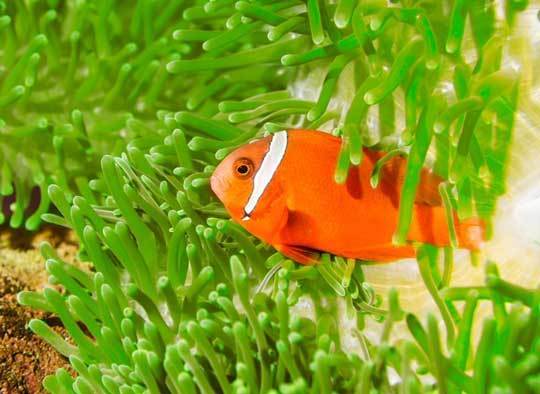
Clownfish usually live in groups with an anemone, and the social structure is rather bizarre. We'll call the group of fish a colony. Each colony includes a breeding pair and then several additional, younger, non-dominant males. The breeding female is the boss, and she gets to live in the best room in the house, the top of the anemone. That's where the most food is (and I suppose it also has the best view).
Now here's where things get kind of weird. All clownfish are born as males. Yep, all of them. When something happens to the breeding female in a colony (the boss)—if she dies, for example—the breeding male switches sexes and becomes the breeding female (that was not a typo). The largest of the juvenile males then experiences a rapid spurt of growth and quickly develops into the breeding male.
Here's a good question... There's one breeding male, right? That male is the boss of the other males (but not of the female). Since that male likes being the one male lucky enough to breed with the female, why doesn't he kick all those smaller males out of the colony so that he doesn't have to worry about them sneaking upstairs and breeding with the female?
Here's the simplified answer. The smaller males modify their growth rate, purposely remaining small and submissive so that they are not a threat to the boss male. That way they get to stay in the colony, hoping to someday have the chance to become the boss male when the breeding female dies.
See? Clownfish are POSITIVE fish—always hopeful!
Below is a Clarkii clownfish.
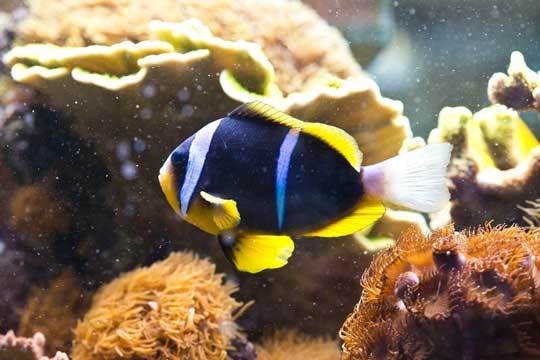
Clownfish are wildly popular among aquarium enthusiasts. In fact, most of those you see in pet shops are bred in captivity rather than caught in the wild (Nemo would like that—he was caught in the wild). Selective breeding has resulted in a wide variety of "designer clownfish," with amazing colors and patterns. Below I put together several striking examples into one image.

So, the Clownfish deserves a place in the S.A.H.O.F.
(Scrumptious Animal Hall of Fame).
FUN FACT: The word scrumptious originated in 1833 in a humor piece about the fictional Major Jack Downing, written by Seba Smith. The word is thought to be a colloquial alteration of sumptuous. The original sumptuous describes something very expensive, of choice materials and fine work. Scrumptious, on the other hand, means "very pleasing, especially to the senses; delectable; splendid." So, it does not refer so much to the expense of what it describes. From Rudyard Kipling: "Whew! What a place! …" said Stalky, filling himself a pipe. "Isn't it scrumptious? …"
So, scrumptious is another way to say awesome!
Photo Credits:
Sea Otters - Wikimedia Commons
Knighting a penguin - Edinburgh Zoo
Macaques with snowballs - Weird Science vis Twitter
Nemo - Sticker image on Amazon product page
Clownfish #1 - GreatBarrierReefs.com
Saddleback clownfish - FishKeepingForever.com
Tomato clownfish - BuildYourAquarium.com
Clarkii clownfish - BuildYourAquarium.com
She said, "Nemo!"
I had to agree. Nemo is a very positive fish. The little guy never gives up and never loses faith. So, for that simple reason, the clownfish is today's Awesome Animal!

What the heck is a Clownfish?
The clownfish, also called the anemonefish, includes about thirty species of fish that form an amazing symbiotic relationship with sea anemones. They are brightly colored, often with various patterns of orange, black, and white.
Clownfish live mostly in coral reefs and shallow lagoons in the Indian and Pacific oceans. Nemo lives near Sydney, Australia, remember?

Amazing facts about Clownfish
Let's talk about this strange relationship between clownfish and anemones.
First a few definitions. Symbiosis is when two living things develop a close, long-term biological relationship with each other. There are three basic types of symbiosis: mutualism, commensalism, and parasitism.
Mutualism is when both organisms benefit. An example is lichens, in which fungi and algae (or sometimes cyanobacteria) live together and benefit from each other.
Commensalism is when one organism benefits, but the other doesn't really care (it isn't helped nor hurt). An example is the remora, a fish that suctions onto a larger fish (like a shark). It gets a free ride and leftover scraps of food, but the larger fish is neither helped nor harmed.
Parasitism is when one organism is benefited while the other is harmed or even killed. A well-known example is the tapeworm, which lives in the intestines of larger animals, stealing the larger animal's ingested food and often weakening the animal (called the host).
In my Diffusion series, humans and tree kangaroos form a symbiotic, mutualistic relationship, in which... well, you'll just have to read the series if you want to know more about that (you'll be glad you did).
Okay, back to the clownfish. Most clownfish species only form relationships with specific species of anemones. In fact, there are over 1,000 species of anemones, but only ten of those species can coexist with clownfish.
This is an example of mutualistic symbiosis. So, both animals benefit.
What does the clownfish get out of this? First, the sea anemone provides protection from predators. Sea anemone tentacles are poisonous and can sting and kill other fish. Second, the clownfish gets to eat scraps of fish left over from the anemone's meals, as well as anemone excrement and the occasional tentacle that breaks off. Third, the clownfish can raise its young in the safety of the tentacles.
What does the anemone get out of this deal? First, the clownfish defends the anemone from parasites and predators. Second, when the clownfish poops on the anemone, the nitrogen from this poop increases the amount of algae growing in the anemone's tissue. Third, if you watch a clownfish, you'll see that it constantly moves around among the anemone's tentacles. This movement helps circulate water around the anemone, increasing the anemone's oxygen intake.
Wow, how awesome is that relationship? Everybody wins! Well, except the prey fish that get attracted to the anemone's deadly stingers.
Below are two saddleback clownfish. Notice the juveniles beneath the anemone—we're going to talk about those in a moment.

Why do clownfish have such bright colors? One idea is that the bright colors attract small fish to the anemone, which are then killed by the anemone's stingers and consumed by the anemone.
Here's a good question... why don't the anemone's stingers harm or kill the clownfish? A layer of mucus on the clownfish's body protects it from the stings. When a clownfish decides to live with a new anemone, it does an elaborate "dance" among the anemone's tentacles. It swims about, touching the tentacles with different parts of its body, until the anemone becomes acclimated to its body.
It's worth pointing out that the fish's mucus is made up mostly of sugars instead of proteins, so it's possible the anemone may not recognize the fish as prey and therefore does not sting.
It's also worth pointing out that clownfish are not really immune to the anemone's stings. Studies have shown that, if the mucus is removed, the anemones can kill the clownfish. So, it's all about the mucus!
Check out this video about the clownfish/anemone relationship.
Below is a tomato clownfish.

Clownfish usually live in groups with an anemone, and the social structure is rather bizarre. We'll call the group of fish a colony. Each colony includes a breeding pair and then several additional, younger, non-dominant males. The breeding female is the boss, and she gets to live in the best room in the house, the top of the anemone. That's where the most food is (and I suppose it also has the best view).
Now here's where things get kind of weird. All clownfish are born as males. Yep, all of them. When something happens to the breeding female in a colony (the boss)—if she dies, for example—the breeding male switches sexes and becomes the breeding female (that was not a typo). The largest of the juvenile males then experiences a rapid spurt of growth and quickly develops into the breeding male.
Here's a good question... There's one breeding male, right? That male is the boss of the other males (but not of the female). Since that male likes being the one male lucky enough to breed with the female, why doesn't he kick all those smaller males out of the colony so that he doesn't have to worry about them sneaking upstairs and breeding with the female?
Here's the simplified answer. The smaller males modify their growth rate, purposely remaining small and submissive so that they are not a threat to the boss male. That way they get to stay in the colony, hoping to someday have the chance to become the boss male when the breeding female dies.
See? Clownfish are POSITIVE fish—always hopeful!
Below is a Clarkii clownfish.

Clownfish are wildly popular among aquarium enthusiasts. In fact, most of those you see in pet shops are bred in captivity rather than caught in the wild (Nemo would like that—he was caught in the wild). Selective breeding has resulted in a wide variety of "designer clownfish," with amazing colors and patterns. Below I put together several striking examples into one image.

So, the Clownfish deserves a place in the S.A.H.O.F.
(Scrumptious Animal Hall of Fame).
FUN FACT: The word scrumptious originated in 1833 in a humor piece about the fictional Major Jack Downing, written by Seba Smith. The word is thought to be a colloquial alteration of sumptuous. The original sumptuous describes something very expensive, of choice materials and fine work. Scrumptious, on the other hand, means "very pleasing, especially to the senses; delectable; splendid." So, it does not refer so much to the expense of what it describes. From Rudyard Kipling: "Whew! What a place! …" said Stalky, filling himself a pipe. "Isn't it scrumptious? …"
So, scrumptious is another way to say awesome!
Photo Credits:
Sea Otters - Wikimedia Commons
Knighting a penguin - Edinburgh Zoo
Macaques with snowballs - Weird Science vis Twitter
Nemo - Sticker image on Amazon product page
Clownfish #1 - GreatBarrierReefs.com
Saddleback clownfish - FishKeepingForever.com
Tomato clownfish - BuildYourAquarium.com
Clarkii clownfish - BuildYourAquarium.com
Published on April 02, 2020 10:53
March 21, 2020
Awesome Animal - Arapaima
Hmm... have I featured a fish before? I don't think so. For the first fish featured as an Awesome Animal, I decided to use one most people probably haven't heard of before.
The Arapaima is unique because it is the largest fish living in freshwater. Another cool feature—it not only can breathe in water, like most fish, but it is also capable of breathing air!
What the heck is an Arapaima?
The arapaima, sometimes also called pirarucu or paiche, is a freshwater fish that lives in the rainforest rivers, swamps, and lakes of the Amazon basin of South America.
There are several species—up to five—but scientists do not all agree on this, and two of the species are so rare that their existence is questionable.

Amazing facts about the Arapaima
The arapaima is a big fish. They can grow over 15 feet (4.5 m) long and weigh up to 440 pounds (200 kg). There are plenty of ocean fish that get this large, but the arapaima is the largest fish that lives exclusively in freshwater.
Unfortunately, since the arapaima is an important food fish for local fishermen, they have been overfished, and their average size is now smaller, more like 7 feet (2.1 m) and 200 pounds (90 kg).
Arapaimas have extremely large scales. Each scale can be 2.4 inches (6 cm) across. As you can see from the photo above, the scales near the tail are often bright red. In fact, the name pirarucu comes from the Tupi language, and the word translates roughly to “red fish.”
Speaking of their scales, these large plates have evolved to be piranha proof! Since the arapaima lives in the same waters as piranhas, this is useful don't you think? The large, tough scales are made of mineralized collagen, making them extremely hard. Not only that, but the scales' corrugated shape makes them flexible so they don't break when piranhas bite.
Below are some kids feeding arapaima fish at a park.

Arapaimas can breathe air. You are probably familiar with the popular pet shop fish sometimes called the Siamese fighting fish (Betta splendens). It is a tiny fish that can live in a very small aquarium without oxygenated water. How does it breathe without much oxygen in the water? The betta fish has an organ called the labyrinth organ, and so does the arapaima.
The labyrinth organ is actually an extension of the gill plates (bone that anchors the gills) and is made of many folds of bone. Tiny blood vessels cover these folds and absorb oxygen from the air, kind of like lungs absorb air.
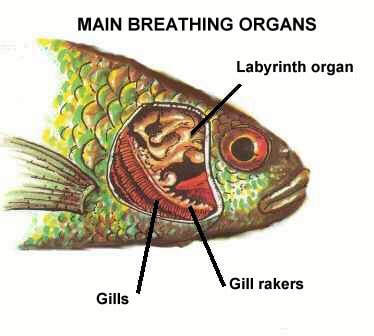
This ability to breathe air allows the arapaima to survive during the low water season when bodies of water become isolated and stagnant. This fish can survive in water with almost no dissolved oxygen (as low as 0.5 ppm).
Here's another benefit for this fish for having a labyrinth organ. During the low water season, other fish struggle to get enough oxygen from the water, and they become very slow and lethargic. Can you guess what arapaimas eat? Yep, other fish. So, they can gulp the air they need and then cruise around, sucking up all the lethargic fish. Like fish in a barrel, as they say.
When an arapaima takes a big gulp of air, it can then stay under water for 10 to 20 minutes before surfacing for another gulp. As you can imagine, they make a loud gulping sound when they do this.
Although arapaimas rarely attack humans, these fish have a habit of leaping out of the water when startled. This sometimes results in the massive fish capsizing the small boats that startle them. So, I suppose in that respect they could be considered dangerous.
Check out this video of a fisherman catching an arapaima.
Because arapaimas must come to the surface to breathe, they are fairly easy for fishermen to catch. The local fishermen often paddle around in their homemade canoes and skewer the fish with harpoons. See the fisherman below with his catch.
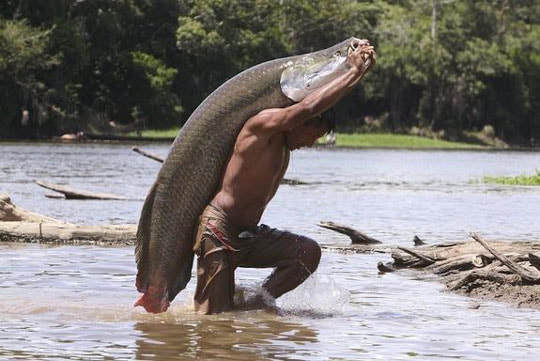
Unfortunately, arapaimas have been heavily overfished, and they have become extinct in some areas of their range. In other areas, their numbers are dwindling fast. Here's the good news, though. In areas where the government is actively regulating arapaima fishing (setting limits, seasons, etc.), these fish are actually thriving. Yay!!! In my opinion, it is a real tragedy when any species goes extinct, particularly when it is a result of human activity.
So, the Arapaime deserves a place in the S.A.H.O.F.
(Sterling Animal Hall of Fame).
FUN FACT: The word sterling, of course, refers to British money and to sterling silver (or things made of sterling silver). The word originated in about 1300, probably from the Middle English word sterre (meaning star), from the stars that were pressed onto certain Norman coins. In the mid 1500s, the word was broadened to refer to "money having the quality of sterling." Then in 1600 it was broadened again to refer to "English money in general." A pound sterling originally meant a pound of sterlings, which was about 240 sterlings. At some point, the word began referring to "capable of standing to a test" (as a a good quality coin would). Then, finally, people started to use the term as an adjective to mean "genuine and reliable" or "first class." For example, of sterling character, or a sterling record of achievement.
So, sterling is another way to say awesome!
Photo Credits:
Tree chewed by beaver - Trish Smith
Beaver chewing tree - AnimatedFX on Flickr
Arapaima #1 - Tennessee Aquarium
Children feeding arapaima - Pinterest
Diagram of Labyrinth organ - My Aquarium Club
Fisherman carrying arapaima - Sergio Ricardo de Oliveira via NBC News
Fishermen with two arapaima - Leandro Castello via LiveScience
The Arapaima is unique because it is the largest fish living in freshwater. Another cool feature—it not only can breathe in water, like most fish, but it is also capable of breathing air!
What the heck is an Arapaima?
The arapaima, sometimes also called pirarucu or paiche, is a freshwater fish that lives in the rainforest rivers, swamps, and lakes of the Amazon basin of South America.
There are several species—up to five—but scientists do not all agree on this, and two of the species are so rare that their existence is questionable.

Amazing facts about the Arapaima
The arapaima is a big fish. They can grow over 15 feet (4.5 m) long and weigh up to 440 pounds (200 kg). There are plenty of ocean fish that get this large, but the arapaima is the largest fish that lives exclusively in freshwater.
Unfortunately, since the arapaima is an important food fish for local fishermen, they have been overfished, and their average size is now smaller, more like 7 feet (2.1 m) and 200 pounds (90 kg).
Arapaimas have extremely large scales. Each scale can be 2.4 inches (6 cm) across. As you can see from the photo above, the scales near the tail are often bright red. In fact, the name pirarucu comes from the Tupi language, and the word translates roughly to “red fish.”
Speaking of their scales, these large plates have evolved to be piranha proof! Since the arapaima lives in the same waters as piranhas, this is useful don't you think? The large, tough scales are made of mineralized collagen, making them extremely hard. Not only that, but the scales' corrugated shape makes them flexible so they don't break when piranhas bite.
Below are some kids feeding arapaima fish at a park.

Arapaimas can breathe air. You are probably familiar with the popular pet shop fish sometimes called the Siamese fighting fish (Betta splendens). It is a tiny fish that can live in a very small aquarium without oxygenated water. How does it breathe without much oxygen in the water? The betta fish has an organ called the labyrinth organ, and so does the arapaima.
The labyrinth organ is actually an extension of the gill plates (bone that anchors the gills) and is made of many folds of bone. Tiny blood vessels cover these folds and absorb oxygen from the air, kind of like lungs absorb air.

This ability to breathe air allows the arapaima to survive during the low water season when bodies of water become isolated and stagnant. This fish can survive in water with almost no dissolved oxygen (as low as 0.5 ppm).
Here's another benefit for this fish for having a labyrinth organ. During the low water season, other fish struggle to get enough oxygen from the water, and they become very slow and lethargic. Can you guess what arapaimas eat? Yep, other fish. So, they can gulp the air they need and then cruise around, sucking up all the lethargic fish. Like fish in a barrel, as they say.
When an arapaima takes a big gulp of air, it can then stay under water for 10 to 20 minutes before surfacing for another gulp. As you can imagine, they make a loud gulping sound when they do this.
Although arapaimas rarely attack humans, these fish have a habit of leaping out of the water when startled. This sometimes results in the massive fish capsizing the small boats that startle them. So, I suppose in that respect they could be considered dangerous.
Check out this video of a fisherman catching an arapaima.
Because arapaimas must come to the surface to breathe, they are fairly easy for fishermen to catch. The local fishermen often paddle around in their homemade canoes and skewer the fish with harpoons. See the fisherman below with his catch.

Unfortunately, arapaimas have been heavily overfished, and they have become extinct in some areas of their range. In other areas, their numbers are dwindling fast. Here's the good news, though. In areas where the government is actively regulating arapaima fishing (setting limits, seasons, etc.), these fish are actually thriving. Yay!!! In my opinion, it is a real tragedy when any species goes extinct, particularly when it is a result of human activity.

So, the Arapaime deserves a place in the S.A.H.O.F.
(Sterling Animal Hall of Fame).
FUN FACT: The word sterling, of course, refers to British money and to sterling silver (or things made of sterling silver). The word originated in about 1300, probably from the Middle English word sterre (meaning star), from the stars that were pressed onto certain Norman coins. In the mid 1500s, the word was broadened to refer to "money having the quality of sterling." Then in 1600 it was broadened again to refer to "English money in general." A pound sterling originally meant a pound of sterlings, which was about 240 sterlings. At some point, the word began referring to "capable of standing to a test" (as a a good quality coin would). Then, finally, people started to use the term as an adjective to mean "genuine and reliable" or "first class." For example, of sterling character, or a sterling record of achievement.
So, sterling is another way to say awesome!
Photo Credits:
Tree chewed by beaver - Trish Smith
Beaver chewing tree - AnimatedFX on Flickr
Arapaima #1 - Tennessee Aquarium
Children feeding arapaima - Pinterest
Diagram of Labyrinth organ - My Aquarium Club
Fisherman carrying arapaima - Sergio Ricardo de Oliveira via NBC News
Fishermen with two arapaima - Leandro Castello via LiveScience
Published on March 21, 2020 09:04
March 11, 2020
Awesome Animal - Babirusa
Sometimes I see a particular animal, and I think, Whoa... that's so weird it's awesome! The Babirusa is just such an animal. It's a pig, but it's very different from all other types of pigs. In fact, it makes me think of some of those long-extinct mammals from prehistoric times.
What the heck is a Babirusa?
Basically, this creature is a pig, but babirusas branched off from the other groups of pigs long ago. They've been separated from the other pigs for somewhere between 10 and 20 million years!
Babirusas grow to about 3.7 feet (1.1 m) long and about 220 pounds (100 kg). The four species of babirusas are found on a few islands in Indonesia, Specifically, the islands of Sulawesi, Togian, Sula, and Buru. Don't those exotic names make you want to go visit these islands?
One of the most astounding things about babirusas is their teeth. I'm not kidding—they have some seriously impressive teeth. Or messed-up teeth, depending on how you look at it.

Amazing facts about Babirusas
Before we talk about the teeth, let's further consider what these creatures really are. As I said above, these creatures are classified in the pig family (Suidae), but they are quite different from other pigs. For example, unlike other pigs, babirusas have complex, two-chambered stomachs, kind of like those of sheep and other ruminant mammals.
Also, babirusas do not have the stiff rostral bone in their snouts like other pigs do. So, their snouts are much softer, and they cannot dig with their snouts except in soft mud.
Babirusas are also called deer-pigs. It is thought that the people of Sulawesi came up with the name babirusa (in Malay, babi = pig, rusa = deer) because the creature's long tusks reminded them of the antlers of deer. But it is also possible that the name comes from the creature's unusually thin legs (for a pig).
Babirusas live in swampy rainforest areas along river banks. They are not picky eaters, and will eat just about anything. They like leaves, fruits, berries, nuts, mushrooms, bark, insects, fish, and small mammals. They are even known to eat smaller babirusas. As I said above, they can't dig with their snouts, but they use their specialized hooves to dig for insect larvae and roots in the ground.
Like many pigs, babirusas are fond of mud. The mud helps them keep parasites off their bodies.

Okay, let's talk about those crazy teeth, which are long enough that they are often called tusks. Both the males and the females have the lower tusks, which can be pretty impressive. They overlap the edge of the creature's snout as they grow upward (there just isn't room inside the mouth!). Even more impressive, though, are the upper tusks, which only the males have.
The first thing to point out is that babirusa teeth never stop growing. As long as the animal is alive, the teeth keep growing larger and longer. The upper tusks start out by growing downward, but then they quickly curve around and start growing upward. Astoundingly, they grow right through the top of the snout.
Then these amazing teeth just keep growing. If they don't break off, or if the males do not grind them down against a hard surface, the tusks will curve all the way back and touch the creature's forehead, Although it is rare, sometimes they will even grow right through the skull into the animal's brain. Yikes!
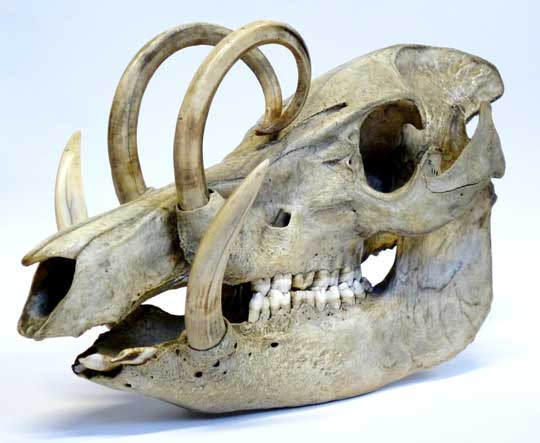
The question is, what is the purpose of such extreme teeth? The answer... we don't know for sure. Originally, and understandably, it was thought that the lower tusks were used by males when they would fight for mates, and the upper tusks protected their eyes during these altercations. Sounds reasonable, right? Sure, until you actually observe male babirusas fighting (which they do often). When they fight, they stand up on their hind legs and box, holding their heads high to protect their tusks, which are actually brittle and are not built to withstand much pressure
Check out this video about Babirusas and their teeth.
So, what are the teeth for? Well, there is a popular story told by locals where babirusas live, which says that the males use them to hang from trees to wait quietly until a female passes by. Umm... I think we can safely rule that idea out as being a whimsical story, right? (although I like the mental image of these creatures hanging around in the rainforest).
Probably, the most likely purpose of the teeth is to impress females (kind of like the tail display of a male peacock). The longer the tusks, the more attractive a male is to the females. However, we won't really know this for sure until extensive studies show it to be true.
Compared to the bizarre appearance of the males, female babirusas look more like other types of pigs. The babies are just as cute as any pig babies (in my opinion).

So, the Babirusa deserves a place in the P.B.A.H.O.F.
(Pure Barry Animal Hall of Fame).
FUN FACT: The phrase pure barry is distinctly Scottish in origin, used primarily in Edinburgh, and its first recorded use was in 1923. The Scottish National Dictionary defines the term to mean: “fine; smart; used to describe something very good of its type.” Example of use: "That Bridgers 1 book is pure barry, mate. Pure barry, that book." So, pure barry is another way to say awesome!
(Thanks to reader Ed Hohmann for telling me about pure barry.)
Photo Credits:
Animal tracks - Stan C. Smith
Sidewinder tracks - HeyPugshund via Tumblr
Fictional woman - https://www.thispersondoesnotexist.com
Babirusa #1 - Dunnock_D licensed CC BY-NC 2.0
Babirusa in mud - SmallAnimalPlanet
Babirusa skull - UNCL Museums and Collections
Female babirusa with piglets - San Diego Zoo
What the heck is a Babirusa?
Basically, this creature is a pig, but babirusas branched off from the other groups of pigs long ago. They've been separated from the other pigs for somewhere between 10 and 20 million years!
Babirusas grow to about 3.7 feet (1.1 m) long and about 220 pounds (100 kg). The four species of babirusas are found on a few islands in Indonesia, Specifically, the islands of Sulawesi, Togian, Sula, and Buru. Don't those exotic names make you want to go visit these islands?
One of the most astounding things about babirusas is their teeth. I'm not kidding—they have some seriously impressive teeth. Or messed-up teeth, depending on how you look at it.

Amazing facts about Babirusas
Before we talk about the teeth, let's further consider what these creatures really are. As I said above, these creatures are classified in the pig family (Suidae), but they are quite different from other pigs. For example, unlike other pigs, babirusas have complex, two-chambered stomachs, kind of like those of sheep and other ruminant mammals.
Also, babirusas do not have the stiff rostral bone in their snouts like other pigs do. So, their snouts are much softer, and they cannot dig with their snouts except in soft mud.
Babirusas are also called deer-pigs. It is thought that the people of Sulawesi came up with the name babirusa (in Malay, babi = pig, rusa = deer) because the creature's long tusks reminded them of the antlers of deer. But it is also possible that the name comes from the creature's unusually thin legs (for a pig).
Babirusas live in swampy rainforest areas along river banks. They are not picky eaters, and will eat just about anything. They like leaves, fruits, berries, nuts, mushrooms, bark, insects, fish, and small mammals. They are even known to eat smaller babirusas. As I said above, they can't dig with their snouts, but they use their specialized hooves to dig for insect larvae and roots in the ground.
Like many pigs, babirusas are fond of mud. The mud helps them keep parasites off their bodies.

Okay, let's talk about those crazy teeth, which are long enough that they are often called tusks. Both the males and the females have the lower tusks, which can be pretty impressive. They overlap the edge of the creature's snout as they grow upward (there just isn't room inside the mouth!). Even more impressive, though, are the upper tusks, which only the males have.
The first thing to point out is that babirusa teeth never stop growing. As long as the animal is alive, the teeth keep growing larger and longer. The upper tusks start out by growing downward, but then they quickly curve around and start growing upward. Astoundingly, they grow right through the top of the snout.
Then these amazing teeth just keep growing. If they don't break off, or if the males do not grind them down against a hard surface, the tusks will curve all the way back and touch the creature's forehead, Although it is rare, sometimes they will even grow right through the skull into the animal's brain. Yikes!

The question is, what is the purpose of such extreme teeth? The answer... we don't know for sure. Originally, and understandably, it was thought that the lower tusks were used by males when they would fight for mates, and the upper tusks protected their eyes during these altercations. Sounds reasonable, right? Sure, until you actually observe male babirusas fighting (which they do often). When they fight, they stand up on their hind legs and box, holding their heads high to protect their tusks, which are actually brittle and are not built to withstand much pressure
Check out this video about Babirusas and their teeth.
So, what are the teeth for? Well, there is a popular story told by locals where babirusas live, which says that the males use them to hang from trees to wait quietly until a female passes by. Umm... I think we can safely rule that idea out as being a whimsical story, right? (although I like the mental image of these creatures hanging around in the rainforest).
Probably, the most likely purpose of the teeth is to impress females (kind of like the tail display of a male peacock). The longer the tusks, the more attractive a male is to the females. However, we won't really know this for sure until extensive studies show it to be true.
Compared to the bizarre appearance of the males, female babirusas look more like other types of pigs. The babies are just as cute as any pig babies (in my opinion).

So, the Babirusa deserves a place in the P.B.A.H.O.F.
(Pure Barry Animal Hall of Fame).
FUN FACT: The phrase pure barry is distinctly Scottish in origin, used primarily in Edinburgh, and its first recorded use was in 1923. The Scottish National Dictionary defines the term to mean: “fine; smart; used to describe something very good of its type.” Example of use: "That Bridgers 1 book is pure barry, mate. Pure barry, that book." So, pure barry is another way to say awesome!
(Thanks to reader Ed Hohmann for telling me about pure barry.)
Photo Credits:
Animal tracks - Stan C. Smith
Sidewinder tracks - HeyPugshund via Tumblr
Fictional woman - https://www.thispersondoesnotexist.com
Babirusa #1 - Dunnock_D licensed CC BY-NC 2.0
Babirusa in mud - SmallAnimalPlanet
Babirusa skull - UNCL Museums and Collections
Female babirusa with piglets - San Diego Zoo
Published on March 11, 2020 08:58
February 19, 2020
Awesome Animal - Vampire Bat
Sometimes I feel compelled to bring justice to certain animals that have an unfairly nasty reputation. Snakes, for example, do not deserve to be almost universally hated. Mice are another example... what could be more harmless than a mouse? Chiggers on the other hand... well, don't get me started on those evil demons from hell.
What do you think of when you hear the name Vampire Bat? I'm guessing that the thoughts going through your head are not exactly pleasant. So, my duty today is to inspire a bit more respect and admiration for this creature.
What the heck is a Vampire Bat?
First of all, not all bats are vampire bats. In fact, of the 1,300 or so species of bats in the world, only THREE of those species are vampire bats. All bats are in the order Chiroptera, and the three species of vampire bats happen to be in the family, Phyllostomidae, also called the leaf-nosed bats. The three species include the common vampire bat, the hairy-legged vampire bat, and the white-winged vampire bat. Vampire bats can be found from Mexico south into South America.
What makes vampire bats so unique among bats is their feeding habits. They have evolved to consume blood, a habit called hematophagy. That's all they eat—blood. No insects, no fruit, no nectar, not even asiago cheese bagels. They don't even drink water. Just blood. This habit, of course, is the source of all the unwarranted human derision of these animals.
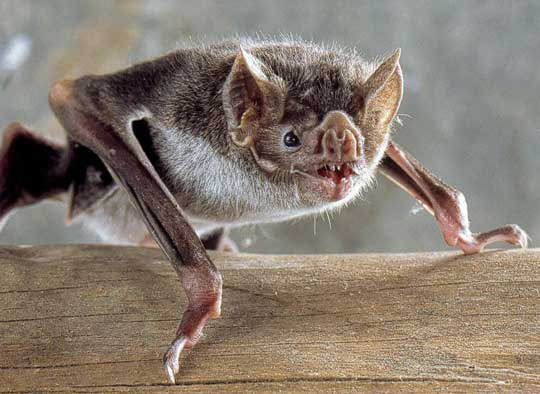
Amazing facts about Vampire Bats
These bats were named after vampires, not the other way around. Since vampire bats live only in the New World, they were not described in scientific literature until 1810. As you probably know, myths about blood-sucking humans called vampires existed long before that. And then, in 1897, Bram Stoker's Dracula was released, and thus was born the silly idea that vampires could shape-shift into the form of a bat. As you can imagine, the vampire bat's reputation went downhill from there. By the way, Stoker also allowed Count Dracula to shape-shift into mist and into a wolf.
Even the medical community has embraced the pop culture association of bats and vampires! A Venezuelan research team isolated a new anticoagulant from one of the vampire bat species. They named the substance "Draculin."
Vampire bats are small, averaging only 3.5 inches (8.9 cm) in body length and two ounces (56 g) in weight, although that weight can double during a good feeding. I mention this because people often assume they are much larger. In fact, Bram Stoker himself wrote the following quote in Dracula: "I have not seen anything pulled down so quick since I was on the Pampas and had a mare ... One of those big bats that they call 'vampires' had got at her during the night and ... there wasn't enough blood in her to let her stand up." Hmm... perhaps Stoker didn't realize vampire bats only weigh two ounces.
Vampire bats very rarely attack humans. That's not to say that they are picky eaters—they will feed on the blood of just about any animal. Mostly they feed on birds and farm animals, but they have been known to feed on porcupines, armadillos, snakes, sea lions, and even penguins. Notice the tiny size of these white-winged vampire bats feeding on a sleeping chicken:

Let's take a closer look at vampire bats' feeding habits. First of all, these bats do not suck blood. Instead, they make a small skin puncture with their needle-sharp teeth, and then they use their tongue to lap up blood that comes from the puncture. They can consume about one ounce (30 ml) in one night, and it usually takes them about thirty minutes to lap up this much blood. As you can probably guess, they only feed at night.
Now this is interesting... If vampire bats go more than 48 hours without a meal, they die. When a vampire bat has a hard time finding enough food during the night, it will fly back to the roost (sometimes a roost may have hundreds of bats). There, the other bats that were more successful will regurgitate their extra blood so that the hungry bats can get enough to eat. Wow! See how friendly vampire bats can be? These creatures have their own social safety net.
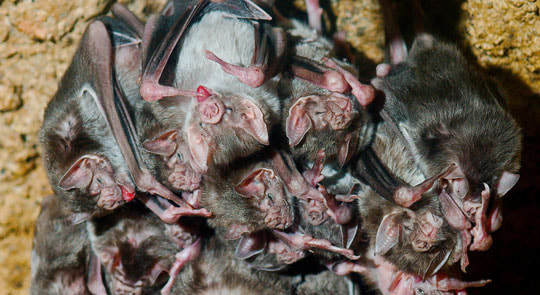
This odd social behavior gets even more amazing. Research has shown that vampire bats will only regurgitate blood for other bats that are either close family or friends. The close family part of that statement is not surprising. It's the friends part that I find most fascinating. As it turns out, while vampire bats are hanging out (literally) in the roost during the day, they make friends. How do they make friends? For a bat to make a friend, it must take the time to groom and socialize with another bat (socializing basically involves snuggling up together). And it takes one to two months of grooming and snuggling before a bat is considered a friend.
Check out this video of vampire bats making friends
So, bats that do not invest the time and effort to make friends are at risk of starving whenever they have a bad night hunting for blood.
See what I mean? Vampires bats have to be friendly! (I wonder if there is a lesson we can learn from this...?)
Let's look at how they actually hunt and feed. These bats have infrared perception in their snouts. These heat-seeking sensors help them find warm-blooded animals and then help them find veins that are near the skin's surface (kind of like my sensors that zero in on a good taco bar). Also, like other bats, vampire bats use echolocation (seeing with sound), allowing them to find their way around in the dark.
Bats are the only mammals that can fly (gliding doesn't count). While most bats cannot walk, vampire bats are the only mammals that have ancestors that evolved flight, then lost the ability to walk, and then re-evolved the ability to walk. Yep, these little guys can scoot along at three feet (1 m) per second. That's pretty useful for an animal that needs to land and then sneak up on a larger animal to steal some blood. Check out the bat's walking mechanics below.
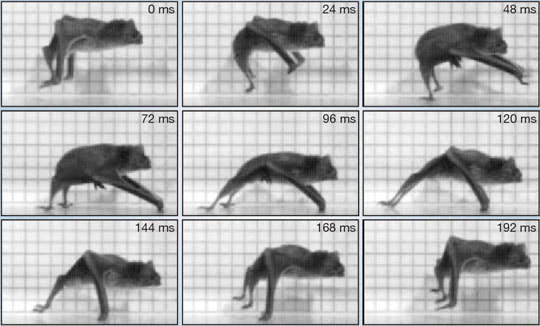
Okay, so the bat lands near its source of food, such as a sleeping cow, then it walks over to the cow and locates a vein near the surface. The bat uses its unbelievably sharp incisor teeth (these teeth do not have enamel, so they remain permanently razor sharp) to puncture the skin. So that the cow's blood does not clot up and stop flowing, the bat's saliva contains anticoagulants (yep, one of those anticoagulants is the one called Draculin).
Usually, the sleeping animal doesn't even know its blood has been stolen.
Finally (and this part is really cool), vampire bats have their favorite restaurants. Let's face it, a 2-ounce bat feeding on a massive pig or cow is risking its life for a meal. The larger animal could step on the bat, roll over on it, or even slap it with a wing, hoof, or tail, smashing it instantly. So, when a bat finds an animal that is particularly easy to feed on (a nice fat vein near the surface, an animal that sleeps soundly, etc.), then the bat will return to that same animal night after night.
How do they find the same animal? Vampire bats can locate their prey by sensing the sound of an animal breathing. In fact, this is so sensitive that they can even recognize the breathing pattern of one specific animal, allowing them to return to that particular buffet night after night.
The vampire bat below is feeding on a donkey's hoof.
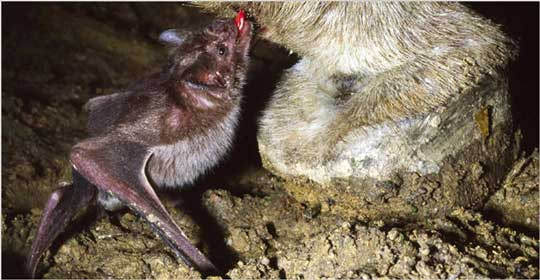
Again, vampire bats rarely feed on humans (humans happen to have hands for swatting, which we can do even when we are asleep, so we are kind of dangerous to these bats). They aren't picky, however, so if you sleep in the open air (without a tent) where vampire bats live, your arms and legs are fair game.
So, the Vampire Bat deserves a place in the L.A.H.O.F.
(Lulu Animal Hall of Fame).
FUN FACT: The word lulu originated in 1886. It refers to any remarkable or outstanding person or thing ("I read my first Bridgers book the other day, and it was a lulu."). This word is thought to have originated as a reference to Lulu Hurst. Who is Lulu Hurst? She was also called the "Georgia Wonder." She was a popular attraction from 1883 to 1885. Supposedly, she possessed a mysterious force that "allowed her to effortlessly move, with just a light touch, umbrellas and canes held tight by others." She was only 15 when she became famous for this act. So, lulu is another way to say awesome!
Photo Credits:
Icy leaves - Stan C. Smith
Snow flake - Wikipedia
Electron microscope image - Wikipedia
Terminator - James Bareham/Polygon
Vampire bat #1 - Uwe Schmidt - Wikimedia Commons
White-winged vampire bats feeding on chicken - Bat Conservation International/J. Scott Altenbach
Vampire bats roosting - Josh More/Flickr
Walking vampire bat - Daniel K. Riskin, John W. Hermanson
Vampire bat feeding on donkey's hoof - Adrian Warren via The New York Times
What do you think of when you hear the name Vampire Bat? I'm guessing that the thoughts going through your head are not exactly pleasant. So, my duty today is to inspire a bit more respect and admiration for this creature.
What the heck is a Vampire Bat?
First of all, not all bats are vampire bats. In fact, of the 1,300 or so species of bats in the world, only THREE of those species are vampire bats. All bats are in the order Chiroptera, and the three species of vampire bats happen to be in the family, Phyllostomidae, also called the leaf-nosed bats. The three species include the common vampire bat, the hairy-legged vampire bat, and the white-winged vampire bat. Vampire bats can be found from Mexico south into South America.
What makes vampire bats so unique among bats is their feeding habits. They have evolved to consume blood, a habit called hematophagy. That's all they eat—blood. No insects, no fruit, no nectar, not even asiago cheese bagels. They don't even drink water. Just blood. This habit, of course, is the source of all the unwarranted human derision of these animals.

Amazing facts about Vampire Bats
These bats were named after vampires, not the other way around. Since vampire bats live only in the New World, they were not described in scientific literature until 1810. As you probably know, myths about blood-sucking humans called vampires existed long before that. And then, in 1897, Bram Stoker's Dracula was released, and thus was born the silly idea that vampires could shape-shift into the form of a bat. As you can imagine, the vampire bat's reputation went downhill from there. By the way, Stoker also allowed Count Dracula to shape-shift into mist and into a wolf.
Even the medical community has embraced the pop culture association of bats and vampires! A Venezuelan research team isolated a new anticoagulant from one of the vampire bat species. They named the substance "Draculin."
Vampire bats are small, averaging only 3.5 inches (8.9 cm) in body length and two ounces (56 g) in weight, although that weight can double during a good feeding. I mention this because people often assume they are much larger. In fact, Bram Stoker himself wrote the following quote in Dracula: "I have not seen anything pulled down so quick since I was on the Pampas and had a mare ... One of those big bats that they call 'vampires' had got at her during the night and ... there wasn't enough blood in her to let her stand up." Hmm... perhaps Stoker didn't realize vampire bats only weigh two ounces.
Vampire bats very rarely attack humans. That's not to say that they are picky eaters—they will feed on the blood of just about any animal. Mostly they feed on birds and farm animals, but they have been known to feed on porcupines, armadillos, snakes, sea lions, and even penguins. Notice the tiny size of these white-winged vampire bats feeding on a sleeping chicken:

Let's take a closer look at vampire bats' feeding habits. First of all, these bats do not suck blood. Instead, they make a small skin puncture with their needle-sharp teeth, and then they use their tongue to lap up blood that comes from the puncture. They can consume about one ounce (30 ml) in one night, and it usually takes them about thirty minutes to lap up this much blood. As you can probably guess, they only feed at night.
Now this is interesting... If vampire bats go more than 48 hours without a meal, they die. When a vampire bat has a hard time finding enough food during the night, it will fly back to the roost (sometimes a roost may have hundreds of bats). There, the other bats that were more successful will regurgitate their extra blood so that the hungry bats can get enough to eat. Wow! See how friendly vampire bats can be? These creatures have their own social safety net.

This odd social behavior gets even more amazing. Research has shown that vampire bats will only regurgitate blood for other bats that are either close family or friends. The close family part of that statement is not surprising. It's the friends part that I find most fascinating. As it turns out, while vampire bats are hanging out (literally) in the roost during the day, they make friends. How do they make friends? For a bat to make a friend, it must take the time to groom and socialize with another bat (socializing basically involves snuggling up together). And it takes one to two months of grooming and snuggling before a bat is considered a friend.
Check out this video of vampire bats making friends
So, bats that do not invest the time and effort to make friends are at risk of starving whenever they have a bad night hunting for blood.
See what I mean? Vampires bats have to be friendly! (I wonder if there is a lesson we can learn from this...?)
Let's look at how they actually hunt and feed. These bats have infrared perception in their snouts. These heat-seeking sensors help them find warm-blooded animals and then help them find veins that are near the skin's surface (kind of like my sensors that zero in on a good taco bar). Also, like other bats, vampire bats use echolocation (seeing with sound), allowing them to find their way around in the dark.
Bats are the only mammals that can fly (gliding doesn't count). While most bats cannot walk, vampire bats are the only mammals that have ancestors that evolved flight, then lost the ability to walk, and then re-evolved the ability to walk. Yep, these little guys can scoot along at three feet (1 m) per second. That's pretty useful for an animal that needs to land and then sneak up on a larger animal to steal some blood. Check out the bat's walking mechanics below.

Okay, so the bat lands near its source of food, such as a sleeping cow, then it walks over to the cow and locates a vein near the surface. The bat uses its unbelievably sharp incisor teeth (these teeth do not have enamel, so they remain permanently razor sharp) to puncture the skin. So that the cow's blood does not clot up and stop flowing, the bat's saliva contains anticoagulants (yep, one of those anticoagulants is the one called Draculin).
Usually, the sleeping animal doesn't even know its blood has been stolen.
Finally (and this part is really cool), vampire bats have their favorite restaurants. Let's face it, a 2-ounce bat feeding on a massive pig or cow is risking its life for a meal. The larger animal could step on the bat, roll over on it, or even slap it with a wing, hoof, or tail, smashing it instantly. So, when a bat finds an animal that is particularly easy to feed on (a nice fat vein near the surface, an animal that sleeps soundly, etc.), then the bat will return to that same animal night after night.
How do they find the same animal? Vampire bats can locate their prey by sensing the sound of an animal breathing. In fact, this is so sensitive that they can even recognize the breathing pattern of one specific animal, allowing them to return to that particular buffet night after night.
The vampire bat below is feeding on a donkey's hoof.

Again, vampire bats rarely feed on humans (humans happen to have hands for swatting, which we can do even when we are asleep, so we are kind of dangerous to these bats). They aren't picky, however, so if you sleep in the open air (without a tent) where vampire bats live, your arms and legs are fair game.
So, the Vampire Bat deserves a place in the L.A.H.O.F.
(Lulu Animal Hall of Fame).
FUN FACT: The word lulu originated in 1886. It refers to any remarkable or outstanding person or thing ("I read my first Bridgers book the other day, and it was a lulu."). This word is thought to have originated as a reference to Lulu Hurst. Who is Lulu Hurst? She was also called the "Georgia Wonder." She was a popular attraction from 1883 to 1885. Supposedly, she possessed a mysterious force that "allowed her to effortlessly move, with just a light touch, umbrellas and canes held tight by others." She was only 15 when she became famous for this act. So, lulu is another way to say awesome!
Photo Credits:
Icy leaves - Stan C. Smith
Snow flake - Wikipedia
Electron microscope image - Wikipedia
Terminator - James Bareham/Polygon
Vampire bat #1 - Uwe Schmidt - Wikimedia Commons
White-winged vampire bats feeding on chicken - Bat Conservation International/J. Scott Altenbach
Vampire bats roosting - Josh More/Flickr
Walking vampire bat - Daniel K. Riskin, John W. Hermanson
Vampire bat feeding on donkey's hoof - Adrian Warren via The New York Times
Published on February 19, 2020 16:51
February 9, 2020
Awesome Animal - Woolly Rhinoceros
My new
Across Horizons
series features many fascinating creatures (some of them scary, some not so much). One animal that makes several important appearances in the first book (titled
Obsolete Theorem
) is the Woolly Rhinoceros.
The woolly rhino, now extinct, is one of those iconic Ice Age creatures, along with such animals as the woolly mammoth, the cave bear, and the saber-toothed cats.
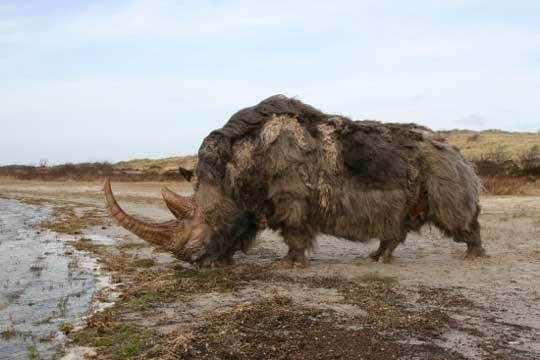
What the heck is a Woolly Rhinoceros?
First, the woolly rhino (Coelodonta antiquitatis) was... well, woolly. It had a long, thick coat of fur to help it stay warm in a freezing climate.
Woolly rhinos stood about 6.5 feet (1.98 m) high at the shoulder. This is taller than most humans and about the size of the modern white rhinoceros. They weighed up to 6,000 pounds (2,721 kg) and were about 12.5 feet (3.8 m) long. Woolly rhinos lived throughout Europe and northern Asia, and they existed from about 350,000 years ago to the end of the last ice age, about 10,000 years ago.
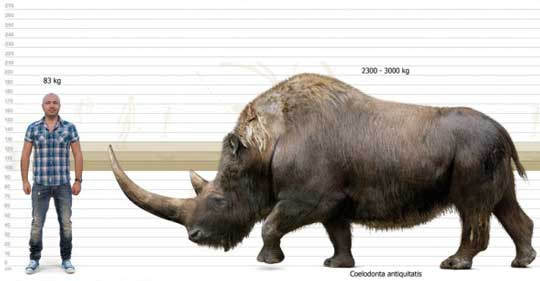
Amazing facts about the Woolly Rhinoceros
The woolly rhino had the widest range of any rhinoceros species. It lived in most of the areas where woolly mammoths lived... except for North America. For some reason, woolly rhinos did not cross the Bering land bridge, although no one seems to know exactly why. I suppose it's possible that a few woolly rhinos made it to North America, but since no remains have been found, there must not have been very many that made it. Some scientists suggest that woolly rhinos didn't cross the land bridge because they could not survive in a tundra environment.
Woolly rhinos had two horns, and the horn on the end of their snout was really long, up to 4.6 feet (1.4 m). This long horn faced forward more than the horns of modern rhinos. Why? It is thought that woolly rhinos used their long horns like a snow shovel, scooping deep snow to the sides so they could eat the plants beneath it.
By the way, rhinoceros horns are made of keratin, the same substance that makes up hair, fingernails, claws, feathers, hooves, calluses, and the outer layer of skin of many animals. Because these horns are made of keratin, and they do not have a bony core like the horns of some animals, rhino horns do not fossilize.
So, if the horns didn't fossilize, how do we know what the horns looked like? Because some woolly rhinos have been found that were preserved in permafrost (soil that is permanently frozen throughout the year). And since woolly rhinos existed relatively recently (10,000 years ago is VERY recent by evolutionary standards), some of these frozen horns are still intact (not fossilized... just frozen). Below is an amazingly well preserved woolly rhino found by gold miners in Siberia in 2007. It died and became permanently frozen about 39,000 years ago, which happens to be fairly close to when Skyra lived. Notice that much of the fur is missing, except on parts of the legs and head.
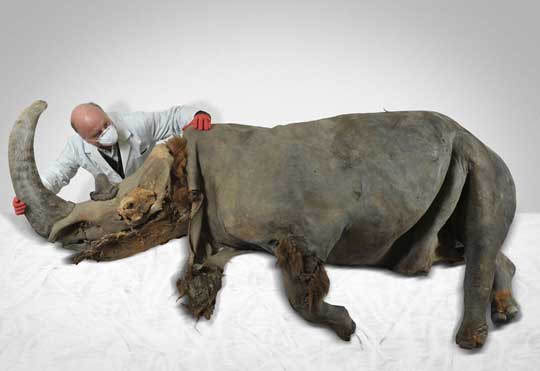
Perhaps an even more remarkable find is Sasha. Sasha is a juvenile woolly rhino found in 2014 (also in Siberia), and in this case nearly all of the fur was intact. Scientists carefully cleaned the 34,000-year-old skin and fur and arranged it in standing pose to show what the creature looked like in life. Kind of cute, huh?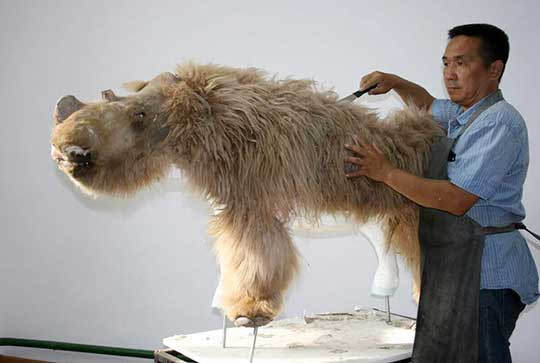
Ancient humans were apparently impressed by woolly rhinos. Images of these creatures are found among numerous cave paintings. Perhaps the most impressive set of cave painting ever found is the Chauvet Cave in southern France. This cave wasn't discovered until 1994, and it is packed with spectacular paintings that have been dated at 30,000 to 33,000 years old. Among the most common animals depicted—the woolly rhino.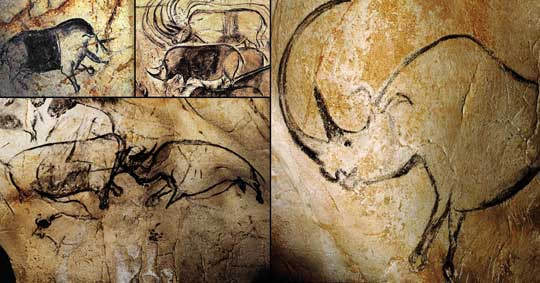
Hmm... these cave paintings stimulate the imagination, don't they? Why did these people 30,000 years ago paint animals on cave walls? This is an interesting question, but the problem is, these people are long gone and we know nothing about their culture and the way they thought about things. So, all we can really do is guess. When someone painted a woolly rhino, were they simply painting the animal they liked to hunt and eat? Or perhaps they were painting a supernatural spirit? Or maybe they were depicting a family member whose soul they believed now exists in the form of an animal. Perhaps the cave could have even been a classroom, in which the children were encouraged to draw whatever came to their minds at the time. I guess we'll never know, will we?
Another thing we may never know for sure is how frequently humans (and Neanderthals) hunted woolly rhinos. Rhino bones have been found alongside human bones in caves, but these particular caves were not natural habitats for either the humans or the rhinos. This suggests that other animals, such as hyenas, may have dragged the bones into these caves.
Some weapons and tools were made with rhino bones, but these could have been bones from carcasses the humans found.
Perhaps the best evidence we have is rhino bones that have marks likely caused by human tools or weapons (some caused by a sharp object, maybe a spear).
Anyway, I'm pretty sure that when humans or Neanderthals encountered a woolly rhino, it was a rather exciting event.
Check out this video of a Neanderthal/woolly rhino encounter.

So, the Woolly Rhinoceros deserves a place in the H.A.H.O.F.
(Humdinger Animal Hall of Fame).
FUN FACT: The first documented use of the word humdinger was in 1883. It is considered an Americanism, and it refers to something or someone truly remarkable (The mayor gave a humdinger of a speech). The word may have originated by combining hummer and dinger, both of which were used to refer to something exceptional. Humdinger is also often used to describe something that is large (It was a humdinger of a storm), which makes this word particularly suited for the woolly rhino. So, humdinger is another way to say awesome!
Photo Credits:
Woolly rhino #1 - ExtinctAnimals.org
Woolly rhino size comparison chart - Prehistoric Fauna
Well-preserved woolly rhino - Vladimir Filippov via Twitter
Sasha the baby woolly rhino - Siberian Times
Chauvet Cave paintings - The Bradshaw Foundation
Last Woolly rhino image - CBS News
The woolly rhino, now extinct, is one of those iconic Ice Age creatures, along with such animals as the woolly mammoth, the cave bear, and the saber-toothed cats.

What the heck is a Woolly Rhinoceros?
First, the woolly rhino (Coelodonta antiquitatis) was... well, woolly. It had a long, thick coat of fur to help it stay warm in a freezing climate.
Woolly rhinos stood about 6.5 feet (1.98 m) high at the shoulder. This is taller than most humans and about the size of the modern white rhinoceros. They weighed up to 6,000 pounds (2,721 kg) and were about 12.5 feet (3.8 m) long. Woolly rhinos lived throughout Europe and northern Asia, and they existed from about 350,000 years ago to the end of the last ice age, about 10,000 years ago.

Amazing facts about the Woolly Rhinoceros
The woolly rhino had the widest range of any rhinoceros species. It lived in most of the areas where woolly mammoths lived... except for North America. For some reason, woolly rhinos did not cross the Bering land bridge, although no one seems to know exactly why. I suppose it's possible that a few woolly rhinos made it to North America, but since no remains have been found, there must not have been very many that made it. Some scientists suggest that woolly rhinos didn't cross the land bridge because they could not survive in a tundra environment.
Woolly rhinos had two horns, and the horn on the end of their snout was really long, up to 4.6 feet (1.4 m). This long horn faced forward more than the horns of modern rhinos. Why? It is thought that woolly rhinos used their long horns like a snow shovel, scooping deep snow to the sides so they could eat the plants beneath it.
By the way, rhinoceros horns are made of keratin, the same substance that makes up hair, fingernails, claws, feathers, hooves, calluses, and the outer layer of skin of many animals. Because these horns are made of keratin, and they do not have a bony core like the horns of some animals, rhino horns do not fossilize.
So, if the horns didn't fossilize, how do we know what the horns looked like? Because some woolly rhinos have been found that were preserved in permafrost (soil that is permanently frozen throughout the year). And since woolly rhinos existed relatively recently (10,000 years ago is VERY recent by evolutionary standards), some of these frozen horns are still intact (not fossilized... just frozen). Below is an amazingly well preserved woolly rhino found by gold miners in Siberia in 2007. It died and became permanently frozen about 39,000 years ago, which happens to be fairly close to when Skyra lived. Notice that much of the fur is missing, except on parts of the legs and head.

Perhaps an even more remarkable find is Sasha. Sasha is a juvenile woolly rhino found in 2014 (also in Siberia), and in this case nearly all of the fur was intact. Scientists carefully cleaned the 34,000-year-old skin and fur and arranged it in standing pose to show what the creature looked like in life. Kind of cute, huh?

Ancient humans were apparently impressed by woolly rhinos. Images of these creatures are found among numerous cave paintings. Perhaps the most impressive set of cave painting ever found is the Chauvet Cave in southern France. This cave wasn't discovered until 1994, and it is packed with spectacular paintings that have been dated at 30,000 to 33,000 years old. Among the most common animals depicted—the woolly rhino.

Hmm... these cave paintings stimulate the imagination, don't they? Why did these people 30,000 years ago paint animals on cave walls? This is an interesting question, but the problem is, these people are long gone and we know nothing about their culture and the way they thought about things. So, all we can really do is guess. When someone painted a woolly rhino, were they simply painting the animal they liked to hunt and eat? Or perhaps they were painting a supernatural spirit? Or maybe they were depicting a family member whose soul they believed now exists in the form of an animal. Perhaps the cave could have even been a classroom, in which the children were encouraged to draw whatever came to their minds at the time. I guess we'll never know, will we?
Another thing we may never know for sure is how frequently humans (and Neanderthals) hunted woolly rhinos. Rhino bones have been found alongside human bones in caves, but these particular caves were not natural habitats for either the humans or the rhinos. This suggests that other animals, such as hyenas, may have dragged the bones into these caves.
Some weapons and tools were made with rhino bones, but these could have been bones from carcasses the humans found.
Perhaps the best evidence we have is rhino bones that have marks likely caused by human tools or weapons (some caused by a sharp object, maybe a spear).
Anyway, I'm pretty sure that when humans or Neanderthals encountered a woolly rhino, it was a rather exciting event.
Check out this video of a Neanderthal/woolly rhino encounter.

So, the Woolly Rhinoceros deserves a place in the H.A.H.O.F.
(Humdinger Animal Hall of Fame).
FUN FACT: The first documented use of the word humdinger was in 1883. It is considered an Americanism, and it refers to something or someone truly remarkable (The mayor gave a humdinger of a speech). The word may have originated by combining hummer and dinger, both of which were used to refer to something exceptional. Humdinger is also often used to describe something that is large (It was a humdinger of a storm), which makes this word particularly suited for the woolly rhino. So, humdinger is another way to say awesome!
Photo Credits:
Woolly rhino #1 - ExtinctAnimals.org
Woolly rhino size comparison chart - Prehistoric Fauna
Well-preserved woolly rhino - Vladimir Filippov via Twitter
Sasha the baby woolly rhino - Siberian Times
Chauvet Cave paintings - The Bradshaw Foundation
Last Woolly rhino image - CBS News
Published on February 09, 2020 05:00
January 31, 2020
Awesome Animal - Narwhal
For some strange reason, one of my favorite parts of the classic movie
Elf
(with Will Ferrell) is the brief scene involving Mr. Narwhal. I can't explain it, but it cracks me up every time (Bye, Buddy. I hope you find your dad.).

Here's a question for you... Do you remember the exact moment you learned that narwhals are actually real? I'm being serious here. I had seen pictures of them when I was a kid, but I just assumed they were some kind of mythical beast, like the giant squid in 20,000 Leagues Under the Sea or the crazy monsters they used to draw in the oceans on those really old maps.
Perhaps learning that narwhals are real is part of how I became so fascinated with animals.
What the heck is a Narwhal?
Narwhals are toothed whales. Toothed whales are those that... well, they have teeth. The group includes dolphins, porpoises, beluga whales, killer whales, sperm whales, and the beaked whales.
Hmm... yes, narwhals are in the toothed whale group, but oddly they only have a few teeth, and they don't chew with those teeth at all. They gum their prey.
By the way... if you were a whale, and you were NOT a toothed whale, you would be a baleen whale. All whales fit into one or the other of these two major groups.
The word narwhal literally means corpse whale. Nar is an Old Norse word that means corpse. Narwhals got this name because their skin is usually mottled gray (like the skin of a drowned sailer), and because in the summer these whales often float at the surface without moving (again, like a drowned sailer).
Often called unicorns of the sea, Narwhals are unique among whales because the males possess a very long tusk, which looks like a unicorn horn. Well, actually that's a silly comparison, because unicorns don't exist. It would be better to say that narwhal tusks look similar to the way artists typical draw horns of the mythical unicorn. Perhaps because people came up with the idea of unicorns after observing narwhals.
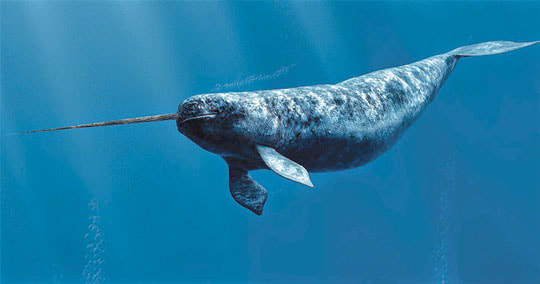
Amazing facts about Narwhals
Let's talk about this crazy tusk first. As I stated above, usually only male narwhals have these. The tusk is actually a modified canine tooth (remember I said they only have a few teeth?). It grows out from the left side of the upper jaw, right through the lip, and it forms a spiral as it grows.
These tusks never stop growing (well, until the whale dies, that is), and they can get up to 10 feet (3.1 m) long! For comparison, male narwhals, not including the tusk, are about 15 feet (4.5 m) long and weigh 3,500 pounds (1,590 kg). Females are slightly smaller.
Usually, it's only the left canine tooth that grows into a tusk. But in one of about every 500 male narwhals the right canine grows out as well. So there are actually narwhals that have TWO tusks. Also, about 15% of the females grow a tusk (although only one female has ever been found that had two tusks... that female was collected in 1684).
Check out this narwhal skull and tusk:

What in the heck is the function of this bizarre tusk? That's a bit of a mystery. Scientists have come up with plenty of explanations. One idea is that the tusk is used as a weapon against predators (polar bears, orcas, and sharks) and to spear fish for their dinner. Or maybe they use it to dig for prey on the ocean floor. Another idea is that they use it to puncture the surface ice to make breathing holes (narwhals live mainly in far north arctic waters). Some scientists have suggested the tusk is an acoustic organ (tusks are hollow, and narwhals communicate with clicks and whistles).
One thing is for sure. The tusk is not essential for survival—most females don't have them, and the females live longer than the males.
The leading theory is that the tusk is for sexual selection. Males are often seen with their heads out of the water, hitting and rubbing their tusks together as if they are sword fighting. This is called tusking, and scientists have often assumed this is a way for males to establish dominance.
But wait! There's more to this mystery. A 2014 study found that narwhal tusks contain millions of highly sensitive nerve endings. These nerve endings are particularly suited to detect ocean water conditions. So, scientists have suggested that when males rub their tusks together, they are actually exchanging information about the nature of the water they have recently traveled through. Whoa... that's cool.
And there's more! In 2016, drones were used to film narwhals, and for the first time ever they were observed using their tusks to stun fish (arctic cod), which they would then eat.
Check out this video showing this feeding behavior.
My guess is that narwhal tusks are multi-purpose tools. Most likely, they are used for sexual selection, but they are apparently useful for a variety of other tasks. They are the Swiss Army knives of the whale world!
One more rather odd thing regarding a narwhal tusk. On November 29 there was a tragic and violent attack that concluded on London Bridge. A knife-wielding man began attacking innocent people at a prison rehabilitation program. Darryn Frost, a civil servant in Britain’s Justice Ministry, grabbed a long narwhal tusk from the wall in Fishmonger's Hall (beside London Bridge), and confronted the man, eventually (along with several others), chasing the man onto London Bridge and subduing him (the attacker was then shot). Anyway, this is the only instance that I know of in which someone used a narwhal tusk as a weapon. Frost is now considered a hero.

The narwhal's closest relative is the beluga whale (which looks like a white narwhal without a tusk). They are so closely related, in fact, that they sometimes mate and produce hybrid offspring. This is very rare, though. In Greenland in 1990, an unusual whale skull was found. The skull was unlike any scientists had seen before, but it had characteristics of both the beluga whale and the narwhal. Finally, in 2019, DNA analysis proved that the skull was indeed a hybrid between the two species.
Below is a 1920 illustration of the two species.

Fortunately, although narwhals are very secretive and difficult to find, they are designated as a species of "least concern" (not threatened or endangered). Scientists estimate the population to be about 125,000.
However, arctic sea ice is melting at an alarming rate, which will result in more ships moving through the waters where narwhals live. Unfortunately, narwhals are vulnerable to ships. They become extremely frightened and stressed when ships pass by. Also, their habit of lying motionless at the surface results in collisions. But for now, they seem to be doing okay.
So, the Narwhal deserves a place in the L.A.H.O.F.
(Lollapalooza Animal Hall of Fame).
FUN FACT: The first documented use of the word lollapalooza was in 1904. It is considered an Americanism, and it refers to something or someone truly remarkable. Oddly, no one seems to know exactly how the word originated. Lollapalooza is also the name of a popular annual music festival. How did the festival get this name? Legend has it that Perry Farrell (of the band Jane's Addiction) named the festival Lollapalooza in 1991 after hearing the word in a Three Stooges short film. So, lollapalooza is another way to say awesome!
Photo Credits:
Scene from Elf - ABC News
Single Narwhal on blue background - University of Washington Magazine
Narwhal skull and tusk - Dinosaur Corporation
Male narwhals tusking - World Wildlife Fund
Darryn Frost with narwhal tusk - Times of Israel
Narwhal and Beluga illustration - Wikipedia

Here's a question for you... Do you remember the exact moment you learned that narwhals are actually real? I'm being serious here. I had seen pictures of them when I was a kid, but I just assumed they were some kind of mythical beast, like the giant squid in 20,000 Leagues Under the Sea or the crazy monsters they used to draw in the oceans on those really old maps.
Perhaps learning that narwhals are real is part of how I became so fascinated with animals.
What the heck is a Narwhal?
Narwhals are toothed whales. Toothed whales are those that... well, they have teeth. The group includes dolphins, porpoises, beluga whales, killer whales, sperm whales, and the beaked whales.
Hmm... yes, narwhals are in the toothed whale group, but oddly they only have a few teeth, and they don't chew with those teeth at all. They gum their prey.
By the way... if you were a whale, and you were NOT a toothed whale, you would be a baleen whale. All whales fit into one or the other of these two major groups.
The word narwhal literally means corpse whale. Nar is an Old Norse word that means corpse. Narwhals got this name because their skin is usually mottled gray (like the skin of a drowned sailer), and because in the summer these whales often float at the surface without moving (again, like a drowned sailer).
Often called unicorns of the sea, Narwhals are unique among whales because the males possess a very long tusk, which looks like a unicorn horn. Well, actually that's a silly comparison, because unicorns don't exist. It would be better to say that narwhal tusks look similar to the way artists typical draw horns of the mythical unicorn. Perhaps because people came up with the idea of unicorns after observing narwhals.

Amazing facts about Narwhals
Let's talk about this crazy tusk first. As I stated above, usually only male narwhals have these. The tusk is actually a modified canine tooth (remember I said they only have a few teeth?). It grows out from the left side of the upper jaw, right through the lip, and it forms a spiral as it grows.
These tusks never stop growing (well, until the whale dies, that is), and they can get up to 10 feet (3.1 m) long! For comparison, male narwhals, not including the tusk, are about 15 feet (4.5 m) long and weigh 3,500 pounds (1,590 kg). Females are slightly smaller.
Usually, it's only the left canine tooth that grows into a tusk. But in one of about every 500 male narwhals the right canine grows out as well. So there are actually narwhals that have TWO tusks. Also, about 15% of the females grow a tusk (although only one female has ever been found that had two tusks... that female was collected in 1684).
Check out this narwhal skull and tusk:

What in the heck is the function of this bizarre tusk? That's a bit of a mystery. Scientists have come up with plenty of explanations. One idea is that the tusk is used as a weapon against predators (polar bears, orcas, and sharks) and to spear fish for their dinner. Or maybe they use it to dig for prey on the ocean floor. Another idea is that they use it to puncture the surface ice to make breathing holes (narwhals live mainly in far north arctic waters). Some scientists have suggested the tusk is an acoustic organ (tusks are hollow, and narwhals communicate with clicks and whistles).
One thing is for sure. The tusk is not essential for survival—most females don't have them, and the females live longer than the males.
The leading theory is that the tusk is for sexual selection. Males are often seen with their heads out of the water, hitting and rubbing their tusks together as if they are sword fighting. This is called tusking, and scientists have often assumed this is a way for males to establish dominance.

But wait! There's more to this mystery. A 2014 study found that narwhal tusks contain millions of highly sensitive nerve endings. These nerve endings are particularly suited to detect ocean water conditions. So, scientists have suggested that when males rub their tusks together, they are actually exchanging information about the nature of the water they have recently traveled through. Whoa... that's cool.
And there's more! In 2016, drones were used to film narwhals, and for the first time ever they were observed using their tusks to stun fish (arctic cod), which they would then eat.
Check out this video showing this feeding behavior.
My guess is that narwhal tusks are multi-purpose tools. Most likely, they are used for sexual selection, but they are apparently useful for a variety of other tasks. They are the Swiss Army knives of the whale world!
One more rather odd thing regarding a narwhal tusk. On November 29 there was a tragic and violent attack that concluded on London Bridge. A knife-wielding man began attacking innocent people at a prison rehabilitation program. Darryn Frost, a civil servant in Britain’s Justice Ministry, grabbed a long narwhal tusk from the wall in Fishmonger's Hall (beside London Bridge), and confronted the man, eventually (along with several others), chasing the man onto London Bridge and subduing him (the attacker was then shot). Anyway, this is the only instance that I know of in which someone used a narwhal tusk as a weapon. Frost is now considered a hero.

The narwhal's closest relative is the beluga whale (which looks like a white narwhal without a tusk). They are so closely related, in fact, that they sometimes mate and produce hybrid offspring. This is very rare, though. In Greenland in 1990, an unusual whale skull was found. The skull was unlike any scientists had seen before, but it had characteristics of both the beluga whale and the narwhal. Finally, in 2019, DNA analysis proved that the skull was indeed a hybrid between the two species.
Below is a 1920 illustration of the two species.

Fortunately, although narwhals are very secretive and difficult to find, they are designated as a species of "least concern" (not threatened or endangered). Scientists estimate the population to be about 125,000.
However, arctic sea ice is melting at an alarming rate, which will result in more ships moving through the waters where narwhals live. Unfortunately, narwhals are vulnerable to ships. They become extremely frightened and stressed when ships pass by. Also, their habit of lying motionless at the surface results in collisions. But for now, they seem to be doing okay.
So, the Narwhal deserves a place in the L.A.H.O.F.
(Lollapalooza Animal Hall of Fame).
FUN FACT: The first documented use of the word lollapalooza was in 1904. It is considered an Americanism, and it refers to something or someone truly remarkable. Oddly, no one seems to know exactly how the word originated. Lollapalooza is also the name of a popular annual music festival. How did the festival get this name? Legend has it that Perry Farrell (of the band Jane's Addiction) named the festival Lollapalooza in 1991 after hearing the word in a Three Stooges short film. So, lollapalooza is another way to say awesome!
Photo Credits:
Scene from Elf - ABC News
Single Narwhal on blue background - University of Washington Magazine
Narwhal skull and tusk - Dinosaur Corporation
Male narwhals tusking - World Wildlife Fund
Darryn Frost with narwhal tusk - Times of Israel
Narwhal and Beluga illustration - Wikipedia
Published on January 31, 2020 05:11
January 9, 2020
Awesome Animal - Flower Mantis
The other day, Trish shared a post with me that featured several photos of a flower mantis. The creature was so beautiful that at first I wondered if it was even real. Well, flower mantises are indeed real. Somehow I had never known about them before!
So, I decided to feature the flower mantis today, in case some of you have never heard of them. Yes, they are real.
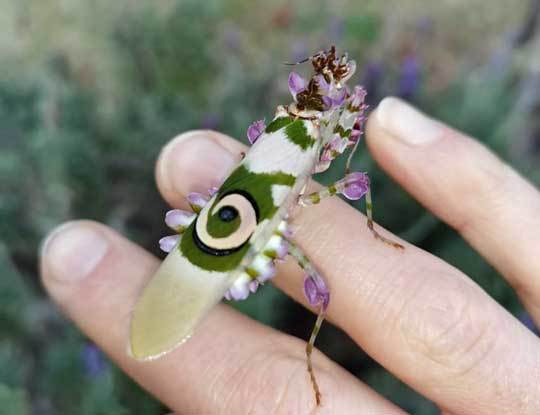
By the way, the person who found the above female flower mantis (in the Nkutu Valley, South Africa) named it Miss Frilly Pants.
What the heck is a Flower Mantis?
The flower mantises include about 1,800 species (wow!), most of them in the family Hymenopodidae. They are found in East Africa, as well as in South and East Asia.
Like all mantises, flower mantises are extremely skilled and deadly predators. This, in fact, is why they look like flowers. They use a strategy called aggressive mimicry, which can most easily be described as a wolf in sheep's clothing. More on that below.
I wish I could provide photos of all 1,800 species, but I'll have to settle on just a few.
Amazing facts about Flower Mantises
Flower mantises are tricky predators. As I mentioned above, they use aggressive mimicry. This is not the same thing as camouflage (which is blending into the surroundings so as to not be detected). Aggressive mimicry is when a predator is disguised as something that is harmless to its prey. In fact, it is usually something that attracts its prey. So, instead of blending into the surroundings (camouflage), the predator stands out so that it is very visible. It just isn't what it appears to be.
Another example of aggressive mimicry is the alligator snapping turtle. The turtle sits on the bottom of a stream or pond, opens its mouth, and wriggles its pink tongue. To a fish, the tongue resembles a wriggling worm. The fish swims right into the turtle's mouth, and.... snap! Hence the name, snapping turtle.
Predators that use aggressive mimicry don't have to go hunting for their prey. They simply sit and wait for the prey to come to them.
By looking like flowers, flower mantises attract pollinating insects that like to feed on the flower nectar. The insects see the "flower," they fly right up to it, and... snap!
Check out the orchid mantis below, beside an actual orchid that it mimics.
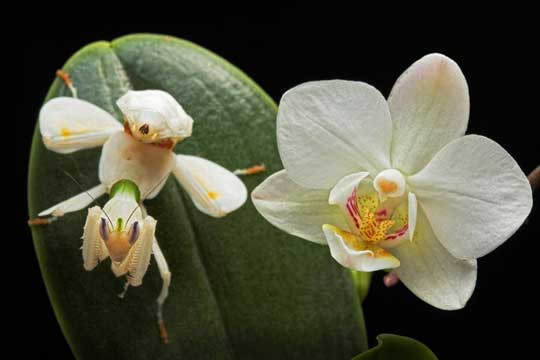
Scientists have been fascinated by flower mantises for well over 100 years. One of the first people to describe them (although incorrectly) was the travel writer James Hingston in 1879. Hingston mistakingly thought that the flower mantis he was watching was actually an insect-eating plant:
"I am taken by my kind host around his garden, and shown, among other things, a flower, a red orchid, that catches and feeds upon live flies. It seized upon a butterfly while I was present, and enclosed it in its pretty but deadly leaves, as a spider would have enveloped it in network."
So, the mantis's mimicry worked so well that it even fooled this human observer.
I feel compelled to further explore this type of mimicry. Actually, for a long time scientists mistakingly believed that flower mantises were an example of cryptic mimicry. In other words, scientists assumed the mantises looked similar to flowers so that they could hide among the flowers and wait for insects that were attracted to the flowers. There are plenty of examples of such cryptic mimicry, such as the crab spider in the photo below, which has just caught an unsuspecting wasp. Keep in mind that the wasp was attracted to the flower itself, not to the spider.
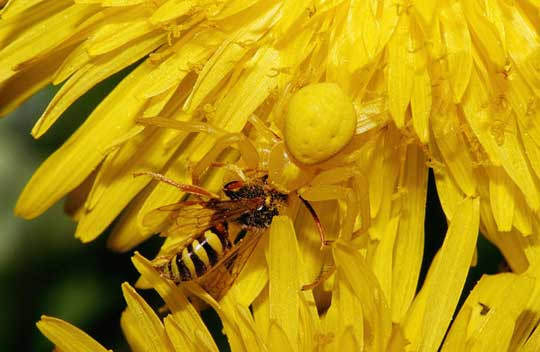
For many years, this is what scientists believed flower mantises were doing. Eventually, however, they began to realize this isn't true of the flower mantis. Flower mantises do not hide within the flowers. In fact, they don't hide at all. They usually sit upon a background of green leaves so that they stand out. They are not trying to hide. They want to be seen.
And this gets even stranger. It turns out that flower mantises are even better at attracting insects than the flowers themselves. If you put a flower mantis side-by-side with a similar flower, insects will visit the mantis more often than the flower.
What? How can that be possible? We have to get into a bit of bug psychology to understand it. When we humans look at a flower mantis, it might fool us at first, but as we look closer, we see that something isn't quite right, and soon we figure out that it is an insect instead of a flower. That's how our brains work. Bees and flies, on the other hand, do not have this capability. They simply see the mantis's color, and they think, "Ooh, a flower... yummy!" Then they dart right in for some nectar, and... snap!
So, insects are simply attracted to the specific color and the general shape of a flower, not really the details. The thing is, flower mantises usually do not look like any one specific type of flower. Instead, they have the characteristics of several kinds of flowers. In other words, they are structured to look like a generalized flower. And they attract more insects because some insects are specific in which type of flower they like... so, it is helpful to the mantis to look like several types!

Flower mantises are actually the first animals we've ever discovered that capture their prey by mimicking a complete flower.
Unlike other mantises that grab prey insects that are crawling on the ground or on a plant, flower mantises grab their prey out of the air. This happens in a fraction of a second, and the mantises are really deadly in their aim.
Check out this cool video about flower mantises.
Since these insects are so amazing to look at, I'll wrap this up by showing a few more examples:


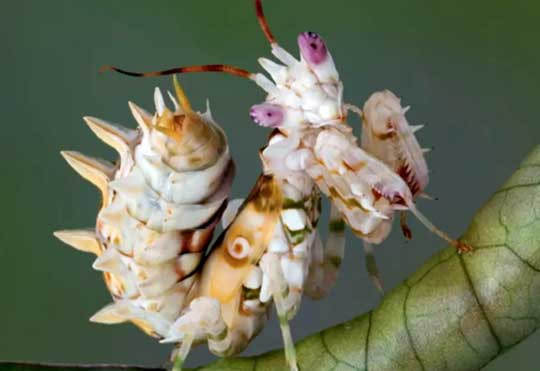
So, the Flower Mantis deserves a place in the R.A.H.O.F.
(Ripsnorter Animal Hall of Fame).
FUN FACT: The first documented use of the word ripsnorter was in 1840. It is considered an Americanism, and it refers to something or someone extraordinary ("That fiddler played a ripsnorter of a song"). It can also refer to something intense or violent ("That was a ripsnorter of a storm"). Flower mantises are definitely extraordinary, and they are also extremely powerful predators. So, it fits. Ripsnorter is another way to say awesome!
Photo Credits:
Flower Mantis #1 - Waterfall Retreat & Environmental Centre Facebook Page
Orchid mantis and orchid - Igor Siwanowicz via The Conversation
Crab spider - Olaf Leillinger/Wikimedia via The Conversation
Purple spiny flower mantis - iNaturalist via Twitter
Very thin flower mantis - PXFuel - Creative Commons
Flower mantis on tip with buds - Roger Meerts/Shutterstock via Discover Magazine
Flower mantis on rolled-up leaf - Thinkstock via Mentalfloss
So, I decided to feature the flower mantis today, in case some of you have never heard of them. Yes, they are real.

By the way, the person who found the above female flower mantis (in the Nkutu Valley, South Africa) named it Miss Frilly Pants.
What the heck is a Flower Mantis?
The flower mantises include about 1,800 species (wow!), most of them in the family Hymenopodidae. They are found in East Africa, as well as in South and East Asia.
Like all mantises, flower mantises are extremely skilled and deadly predators. This, in fact, is why they look like flowers. They use a strategy called aggressive mimicry, which can most easily be described as a wolf in sheep's clothing. More on that below.
I wish I could provide photos of all 1,800 species, but I'll have to settle on just a few.
Amazing facts about Flower Mantises
Flower mantises are tricky predators. As I mentioned above, they use aggressive mimicry. This is not the same thing as camouflage (which is blending into the surroundings so as to not be detected). Aggressive mimicry is when a predator is disguised as something that is harmless to its prey. In fact, it is usually something that attracts its prey. So, instead of blending into the surroundings (camouflage), the predator stands out so that it is very visible. It just isn't what it appears to be.
Another example of aggressive mimicry is the alligator snapping turtle. The turtle sits on the bottom of a stream or pond, opens its mouth, and wriggles its pink tongue. To a fish, the tongue resembles a wriggling worm. The fish swims right into the turtle's mouth, and.... snap! Hence the name, snapping turtle.
Predators that use aggressive mimicry don't have to go hunting for their prey. They simply sit and wait for the prey to come to them.
By looking like flowers, flower mantises attract pollinating insects that like to feed on the flower nectar. The insects see the "flower," they fly right up to it, and... snap!
Check out the orchid mantis below, beside an actual orchid that it mimics.

Scientists have been fascinated by flower mantises for well over 100 years. One of the first people to describe them (although incorrectly) was the travel writer James Hingston in 1879. Hingston mistakingly thought that the flower mantis he was watching was actually an insect-eating plant:
"I am taken by my kind host around his garden, and shown, among other things, a flower, a red orchid, that catches and feeds upon live flies. It seized upon a butterfly while I was present, and enclosed it in its pretty but deadly leaves, as a spider would have enveloped it in network."
So, the mantis's mimicry worked so well that it even fooled this human observer.
I feel compelled to further explore this type of mimicry. Actually, for a long time scientists mistakingly believed that flower mantises were an example of cryptic mimicry. In other words, scientists assumed the mantises looked similar to flowers so that they could hide among the flowers and wait for insects that were attracted to the flowers. There are plenty of examples of such cryptic mimicry, such as the crab spider in the photo below, which has just caught an unsuspecting wasp. Keep in mind that the wasp was attracted to the flower itself, not to the spider.

For many years, this is what scientists believed flower mantises were doing. Eventually, however, they began to realize this isn't true of the flower mantis. Flower mantises do not hide within the flowers. In fact, they don't hide at all. They usually sit upon a background of green leaves so that they stand out. They are not trying to hide. They want to be seen.
And this gets even stranger. It turns out that flower mantises are even better at attracting insects than the flowers themselves. If you put a flower mantis side-by-side with a similar flower, insects will visit the mantis more often than the flower.
What? How can that be possible? We have to get into a bit of bug psychology to understand it. When we humans look at a flower mantis, it might fool us at first, but as we look closer, we see that something isn't quite right, and soon we figure out that it is an insect instead of a flower. That's how our brains work. Bees and flies, on the other hand, do not have this capability. They simply see the mantis's color, and they think, "Ooh, a flower... yummy!" Then they dart right in for some nectar, and... snap!
So, insects are simply attracted to the specific color and the general shape of a flower, not really the details. The thing is, flower mantises usually do not look like any one specific type of flower. Instead, they have the characteristics of several kinds of flowers. In other words, they are structured to look like a generalized flower. And they attract more insects because some insects are specific in which type of flower they like... so, it is helpful to the mantis to look like several types!

Flower mantises are actually the first animals we've ever discovered that capture their prey by mimicking a complete flower.
Unlike other mantises that grab prey insects that are crawling on the ground or on a plant, flower mantises grab their prey out of the air. This happens in a fraction of a second, and the mantises are really deadly in their aim.
Check out this cool video about flower mantises.
Since these insects are so amazing to look at, I'll wrap this up by showing a few more examples:



So, the Flower Mantis deserves a place in the R.A.H.O.F.
(Ripsnorter Animal Hall of Fame).
FUN FACT: The first documented use of the word ripsnorter was in 1840. It is considered an Americanism, and it refers to something or someone extraordinary ("That fiddler played a ripsnorter of a song"). It can also refer to something intense or violent ("That was a ripsnorter of a storm"). Flower mantises are definitely extraordinary, and they are also extremely powerful predators. So, it fits. Ripsnorter is another way to say awesome!
Photo Credits:
Flower Mantis #1 - Waterfall Retreat & Environmental Centre Facebook Page
Orchid mantis and orchid - Igor Siwanowicz via The Conversation
Crab spider - Olaf Leillinger/Wikimedia via The Conversation
Purple spiny flower mantis - iNaturalist via Twitter
Very thin flower mantis - PXFuel - Creative Commons
Flower mantis on tip with buds - Roger Meerts/Shutterstock via Discover Magazine
Flower mantis on rolled-up leaf - Thinkstock via Mentalfloss
Published on January 09, 2020 05:44



